Chapter XIV
THE MAYA
TRIBES.
The geographical location of the Maya
tribes—Description of Copan—Statue at
Copan—Altars at Copan—Ruins at Quiriga
Patinamit—Utatlan—Description of Palenque—The
Palace at Palenque—The Temple of the Three
Inscriptions—Temple of the Beau-relief—Temple of the
Cross—Temple of the Sun—Maler's Temple of the
Cross—Significance of the Palenque crosses—Statue at
Palenque—Other ruins in Tobasco and Chiapas—Ruins in
Yucatan—Uxmal—The Governor's House—The
Nunnery—Room in Nunnery—The sculptured
façades—Temple at
Uxmal—Kabah—Zayi—Labna—Labphak—Chichen-Itza—The
Nunnery—The Castillo—The Gymnasium—M. Le
Plongon's researches—The tradition of the Three
Brothers—Chaac-mol—Antiquity of Chichen.
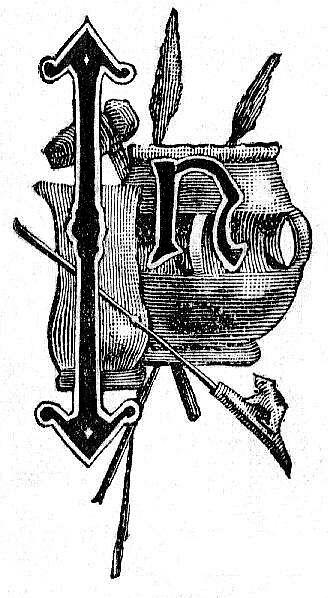 THE Central American region of
the Western Continent are found the ruins of what are pronounced
by all scholars to be the highest civilization, and the most
ancient in time, of any in the New World. There it arose,
flourished, and tottered to its fall. Its glory had departed, its
cities were a desolation, before the coming of the Spaniards. The
explorer who would visit them finds himself confronted with very
great difficulties. Their location is in a section of the country
away from the beaten track of travel. Their sites are overspread
with the luxuriant vegetation of tropical lands, through which
the Indian's machete must carve a passage. The states in which
they are situated are notorious for anarchy and misrule, and the
climate is such that it is dangerous for those not acclimated to
venture thither during a large part of the year. So it is not
strange that but few have wandered among these ruins, and
described them to the world at large.
THE Central American region of
the Western Continent are found the ruins of what are pronounced
by all scholars to be the highest civilization, and the most
ancient in time, of any in the New World. There it arose,
flourished, and tottered to its fall. Its glory had departed, its
cities were a desolation, before the coming of the Spaniards. The
explorer who would visit them finds himself confronted with very
great difficulties. Their location is in a section of the country
away from the beaten track of travel. Their sites are overspread
with the luxuriant vegetation of tropical lands, through which
the Indian's machete must carve a passage. The states in which
they are situated are notorious for anarchy and misrule, and the
climate is such that it is dangerous for those not acclimated to
venture thither during a large part of the year. So it is not
strange that but few have wandered among these ruins, and
described them to the world at large.
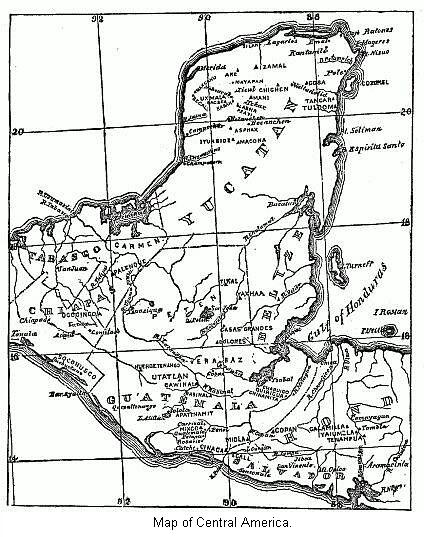
But the accounts thus presented are
interesting in the extreme, though they have raised many
questions that have thus far defied solution. There is no doubt
but what there exist large groups of ruins not yet described,
structures and monuments which might, perhaps, throw some light
on a past that now seems hopelessly lost. But the ruins thus far
described are so numerous, their similarity is so evident, that
we feel we have but little to hope from such undiscovered ruins.
There are, doubtless, richly ornamented façades,
grotesquely sculptured statues, and hieroglyphic-covered altars,
but they would prove as much of an enigma as those already known.
Our only hope is that some fortunate scholar will yet discover a
key by whose aid the hieroglyphics now known may be read. Then,
but not until then, will the darkness that now enshrouds ancient
Maya civilization be dissipated.
As will be seen from a glance at the map, the
most important ruins are in the modern states of Honduras,
Guatemala, Chiapas, and especially Yucatan, the northern portion
of this peninsula being literally studded with them. The river
Usumacinta and its numerous tributaries flowing in a northern
direction through Chiapas is regarded as the original home of the
civilization whose ruins we are now to describe. From whence the
tribes came that first settled in this valley is as yet an
unsettled point. We notice that we have here another instance of
the influence that fertile river valleys exert upon tribes
settling therein. The stories told us of the civilization that
flourished in primitive times in the valleys of the Euphrates and
the Nile are not more wonderful—the ruins perhaps not more
impressive—than are the traditions still extant, or the
material remains fallen in picturesque ruins, of the civilization
that once on a time held sway in the Usumacinta Valley.
One of the most famous groups of ruins in this
section of the country is that of Copan, situated in Honduras,
but very near the Guatemala line. This is commonly spoken of as
"the oldest city in America,"1
and has some evidence to substantiate this claim. Whatever be its
relative antiquity, it is doubtless very old, as it was probably
in ruins at the time of the conquest. There are several facts
going to prove this assertion. When Cortez, in 1524, made his
march to Honduras, he passed within a few leagues of this place.
He makes no mention of it, which he would have been very apt to
do had it been inhabited. Fifty years later Garcia De Palacio
made a report on these ruins to the king of Spain. According to
this report, it was then in much the same state as described by
modern travelers, and the same mystery surrounded it, showing
that it must have been in ruin much longer than the short space
of time from the conquest to the date of his report. But few
travelers have visited Copan, and fewer still have left a good
description of it. Mr. Stephens, accompanied by Mr. Catherwood,
explored it in 1839, and this constitutes our main source of
information.2
We feel that here is the place to speak a word
of caution. In common with other writers, we have used the word
cities, in speaking of the ruins of Maya civilization. In view of
the criticisms that have been freely expressed by some of the
best scholars of American ethnology, as to the generally accepted
view of the civilization of the Mexican and Central American
races, it is necessary to be on our guard as to the language
employed. In the case of Copan, for instance, all the remains
known, occur in an irregularly inclosed space of about nine
hundred by sixteen hundred feet, while but a portion of such
inclosed space is covered by the ruins themselves. Now it can, of
course, be said that this space contains simply the remains of
public buildings, so to speak—such as temples, palaces, and
others—while the habitations of the great body of the
common people, poorly built, and located outside of this area,
may have vanished away. But, on the other hand, it may also be
that in this small area we have the ruins of all the buildings
that ever stood at Copan. In which case the word city is a
misnomer; pueblo would be more appropriate. But looking at them
in the simplest light, we shall find there is still a great deal
to excite astonishment. Fragments of the wall originally
inclosing the area in which are located the temple pyramids and
statues, are still to be found. Very few particulars have been
given of this wall. It was made of blocks of stone, and seems to
have been twenty-five feet thick at the base, but the height is
not given. The northern half of this area is occupied by a large
terrace, somewhat irregular in outline, and impressed Mr.
Stephens with the idea that it had not all been erected at the
same time, but additions had been made from time to time. Instead
of describing the ruins in full, we will let the illustration
speak for itself. The dimensions of this terrace are, six hundred
and twenty-four feet by eight hundred and nine feet. The side
fronting on the river was perpendicular. The other three sides
consist of ranges of steps and pyramidal structures. All these
steps and pyramidal sides were once painted. The general height
of the terrace was about seventy feet above the surface of the
ground.

Though Mr. Stephens warns us that this terrace
was not as large as the base of the Pyramid of Ghizeh, still it
must have required an immense amount of work, since careful
computations show that over twenty-six million cubic feet of
stone were used in its construction. This stone was brought from
the quarries two miles away. We must not forget that this work
was performed by a people destitute of metallic tools.
On the terrace were the ruins of four
pyramids, one rising to the height of one hundred and twenty-two
feet. The surface of the terrace was not continuous. In two
places there were court-yards, or sunken areas. The larger is
ninety by one hundred and forty-four feet, and has a narrow
passage-way leading into it from the north. Whatever buildings
that once stood on this terrace, have vanished away. At one place
only, on the terrace, fronting the river, are the remains of
small, circular towers, thought to have been watch towers. The
whole terrace was thickly overgrown by trees of a tropical
growth. Mr Stephens noticed two immense Ceiba trees growing from
the very summit of one of the pyramids. This structure has been
called the Temple, and a great many surmises have been made as to
the scenes once enacted there. If analogous to other structures
in Central America, this terrace was surmounted with buildings.
They may have been temples or palaces, or they may have been
communal houses, not unlike those of New Mexico, to the
north.
But of more importance than the ruins of this
temple, are the statues and altars peculiar to this region. Mr.
Stephens found fourteen of them. It seems very singular, indeed,
to come upon these statues in the depth of a Central American
forest, and they give us an idea of the state of advancement of
these old tribes that nothing else does. They raise many queries.
Why is it that so many are found here—so few elsewhere? Are
they statues of noted personages, or idols? We are powerless to
answer these questions. These secrets will only be yielded up
when the hieroglyphics with which they are covered shall be
read.
The places where these statues are found is
seen to the right of the main body of ruins. It will be seen that
only one is within the terrace area of the temple. Three others
are situated near it, but the majority are near the southern end
of the inclosure. We are not given the dimensions of all, but the
smallest one given is eleven feet, eight inches high, by three
feet, four inches width and depth; the largest, thirteen feet
high, four feet wide, and three feet deep. No inconsiderable part
of the labor on the statues must have been that of quarrying the
large blocks of stone out of which they were carved, and
transporting them to the place where found. They came from the
same quarry as the other stones used in building; and so were
transported a distance of about two miles. Mr. Stephens found,
about midway to the quarry, a gigantic block, "which was probably
on its way thither, to be carved and set up as an ornament, when
the labors of the workmen were arrested."
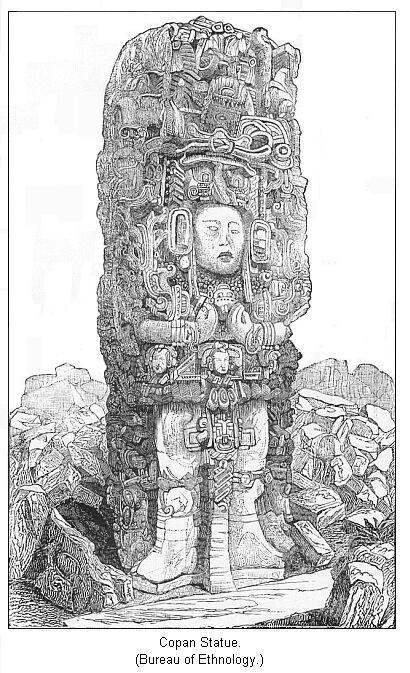
There is such a similarity in all these
statues that a representation of one will suffice. This is the
representation of one of the largest statues. It is seen to be
standing on a sort of pedestal. A face occupies a central
position on the front. Some of the faces have what may be a
representation of a beard. In all but one, the expression is calm
and peaceful. They were once painted red. Traces of color were
still visible at the time of Mr. Stephens's visit. In all but one
the hands are represented as placed back to back on the
breast.
The complicated headdress and the ornaments on
the robes utterly defy description. The sides and back of the
statues are covered with hieroglyphics, though now and then a
face is introduced. A side view of another statue shows this
feature. All are convinced that we have in these hieroglyphics an
explanation of each statue, but what it is, is yet unknown. Mr.
Stephens says: "Of the moral effect of the monuments themselves,
standing as they do, in the depths of a tropical forest, silent
and solemn, strange in design, excellent in sculpture, rich in
ornament, different from the works of any other people; their
uses and purposes—their whole history—so entirely
unknown, with hieroglyphics explaining all, but perfectly
unintelligible, I shall not pretend to convey any idea. Often the
imagination was pained in gazing at them. The tone which pervades
the ruins is that of deep solemnity."
In front of most of the statues is what is
called an altar, which would seem to imply that these monuments
are really idols. "The altars, like the idols, are all of a
single block of stone. In general, they are not so richly
ornamented, and are more faded and worn, or covered with moss.
Some were completely buried, and of others it was difficult to
make out more than the form. All differed in position, and
doubtless had some distinct and peculiar reference to the idols
before which they stood."
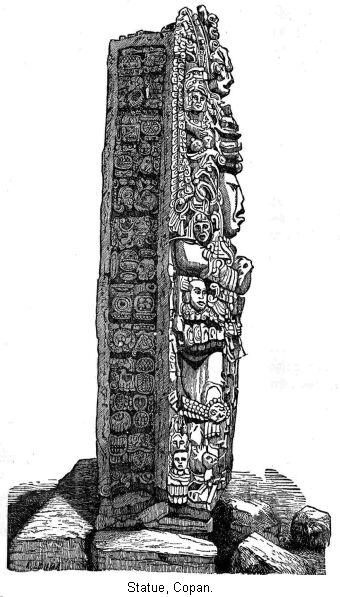
These altars are strongly suggestive of
sacrificial scenes. The altar before the idol found in the
court-yard on the terrace of the temple, is one of the most
interesting objects found at Copan. It is six feet square and
four feet high. The top is divided into thirty-six tablets of
hieroglyphics which we may well imagine records some events in
the history of this mysterious people. Each side has carved on it
four human figures. They are generally all represented as facing
the same way. We give an illustration of the east side. Each
individual is sitting cross-legged on a hieroglyphic, and has a
ponderous head-dress.

Mr Stephens found the quadrangle at the
south-east corner of the plan to be thickly strewn with fragments
of fine sculpture. Amongst the rest was a "remarkable portrait."
(Shown later.) "It is probably the portrait of some king,
chieftain, or sage. The mouth is injured, and part of the
ornament over the wreath that crowns the head. The expression is
noble and severe, and the whole character shows a close imitation
of nature." Colonel Gallindo, who visited Copan in 1835,
discovered a vault very near where the circular towers are
located, on the terrace fronting the river. This vault was five
feet wide, ten feet long, and four feet high. It was used for
burial purposes. Over fifty vessels of red pottery, containing
human bones, were found in it.3

In this hasty sketch we do not feel that we
have done justice to Copan. It is, however, all the space we can
devote to this interesting ruin. We call special attention to the
hieroglyphics on the altar and the statues. We will find other
hieroglyphics at Palenque, and in Yucatan, evidently derived from
these.4 They have been made the
subject of very interesting study, and we will refer to them
again at another page. We also notice especially the fact that we
have no ruined buildings at Copan. In this respect it stands
almost alone among the Central American ruins. The distinguishing
features, however, are the carved obelisks. They are evidently
not the work of rude, people. Mr. Stephens, who was every way
qualified to judge, declares that some of them "are in every way
equal to the finest Egyptian workmanship, and that with the best
instruments of modern times, it would be impossible to cut stone
more perfectly."

A dark mystery hangs over these ruins. Their
builders are unknown. Whether we have here some temple sacred to
the gods of the Maya pantheon or some palace made resplendent for
royal owners, who can tell? Whether these are the ruins of the
more substantial public buildings of a great city, of which all
other buildings have vanished—or whether this is the
remains of a prosperous pueblo, whose communal houses crowded the
terraces, with sacrificial altars on the lofty pyramids—who
knows? At long intervals a passing traveler visits them, ponders
over their fast disappearing ruins, and goes his way. The veil
drops, the tropical forest more securely environs them—and
thus the years come and go over the ruins of Copan.
Nearly north from Copan (see map), about
half-way to the coast, on the bank of the river Montagua, is
found a small hamlet, by the name of Quiriga. Mr. Stephens, when
traveling in the country in 1840, after many careful inquiries,
heard of ruins near that place. Though not able to explore them
himself, his companion, Mr. Catherwood, did. The result of this
gentleman's exertion makes us acquainted with another group of
ruins, in many respects similar to those of Copan, though
apparently much farther gone in decay. His visit was a very
hurried one; and he was not able to clear the moss away from the
statues so as to draw them as it should be done.5
We must notice that, though called a city, all
the monuments and fragments thus far brought to light are
scattered over a space of some three thousand square feet. No
plan has been given. We gather, however, from Stephens's work,
that a pyramidal wall inclosed the ruins, as at Copan.6 No dimensions of this wall are given.
Within the inclosure (if such it was) was a terrace. Here, again,
dimensions are not given; but we are told it was about
twenty-five feet to the top, and that the steps were, in some
places, still perfect. It was constructed of neatly cut sandstone
blocks. No monuments or altars were observed on the terrace, but
in close proximity to it were fragments of sculpture. At another
place near the wall, Mr. Catherwood mentions eight standing
statues, one fallen one, and saw fragments of at least thirteen
others. They are represented as being very similar to those of
Copan, but two or three times as high. The hieroglyphics are
pronounced identical with those already described.
There are no traditions extant of these ruins.
No thorough exploration has been made. A city may have stood
there; but, if so, its name is lost, its history unknown. "For
centuries it has lain as completely buried as if covered with the
lava of Vesuvius. Every traveler from Yzabel to Guatemala has
passed within three hours of it. We ourselves have done the same;
and yet there it lay, like the rock-built city of Edom,
unvisited, unsought, and utterly unknown."
A large extent of territory in Guatemala and
Yucatan is as yet an unknown country, or at least has never been
thoroughly explored. Strange stories have flitted here and there
of wonders yet to be seen. The country swarms with savages,
living in much the same state as they were when the Spaniards
invaded the country. They have never been conquered, and, in the
rugged fastnesses of their land, bid defiance to all attempts to
civilize them. From all we can learn, there are numerous groups
of ruins scattered here and there—but of their nature we
are, as yet, mostly in the dark.
We have, indeed, historical notices of a few
places; but, as the color of an object is the same as that of the
medium through which it is viewed, we can not help thinking that
the glamour of romance, which the early Spanish writers threw
around all their transactions in the New World, has woefully
distorted these sketches. This same effect is to be noticed in
all the descriptions of the ruins. Where one party sees the ruins
of imperial cities, another can detect but the ruins of imposing
pueblos, with their temples and pyramids. It can be truthfully
stated, that this is a land of ruins. Every few leagues, as far
as it has been explored, are the remains of structures that
excite astonishment.
The meager reports given us raise our
curiosity, but fail to satisfy it. Almost all explorers relate
stories of the existence of an aboriginal city. The location of
this city shifts from place to place; always, however, in a
section of country where no white men are allowed to intrude. The
Curé of Santa Cruz, in whom Mr. Stephens expressed
confidence, declared that he had, years before, climbed to the
summit of a lofty sierra, and then "he looked over an immense
plain, extending to Yucatan and the Gulf of Mexico, and saw, at a
great distance, a large city, spread over a great space, with
turrets white and glittering in the sun." We are afraid a search
for this mythical city would be attended with much the same
results as rewards the child's pursuit of a golden treasure at
the end of the rainbow.
As a sample of known ruins, we might cite two
in the immediate neighborhood of Quirigua. At the distance of a
few leagues, both above and below this latter place, are the
remains of former settlements. The accounts are very brief. Of
the ruins below, we are informed that they consist of the remains
of a quadrilateral pyramid, with traced sides, up which steps
lead to the summit platform, where débris of hewn
stone are enveloped in dense vegetation." Of the ruins located
above Quirigua, we are simply told "of a large area covered with
aboriginal relics—in the form of ruined stone structures,
vases and idols of burned clay, and monoliths, buried for the
most part in the earth."
These descriptions will serve as samples of
many others, and, though they are interesting in their way, we
are afraid they would grow tiresome by repetition. We will,
therefore, only make mention of one or two important points;
premising, however, that, beyond a doubt, similar ruins are
scattered up and down the river valleys of the entire country.7
Two cities of ancient Guatemala especially
mentioned by Spanish writers are Utatlan and Patinamit. Here, if
we may believe their recitals, were the capitals of two powerful
monarchies. The pictures they draw for us are those of cities of
Oriental magnificence. The system of government they describe is
that of absolute monarchy, founded on feudalism. We will briefly
glance at the remains of these "imperial cities." Their location
is seen on the map. The approach to Patinamit is very difficult,
indeed. Situated on a high table-land, it commands an almost
boundless view. On every side are immense ravines, and the only
way of entering it was by a narrow passage cut in the side of the
ravine, twenty or thirty feet deep, and not wide enough for two
horsemen to ride abreast.
Mr. Stephens mentions coming to a wall of
stone, but broken and confused. The ground beyond was covered
with mounds of ruins, and in one place he saw the foundations of
two buildings, one of them being one hundred and fifty by fifty
feet. He does not give us the area covered by the ruins, but
there is nothing in his description to make us think it very
large in extent. He also quotes for us Fuentes's description of
this same place, written, however, one hundred and forty years
earlier. In this he speaks of the remains of a magnificent
building, perfectly square, each side measuring one hundred
paces, constructed of hewn stones, extremely well put together.
In front of the building is a large square, on one side of which
stand the ruins of a sumptuous palace; and near to it are the
foundations of several houses.8
He also asserts that traces of streets could still be seen, and
that they were straight and spacious, crossing each other at
right angles. Fuentes certainly had remarkable eyes. He wrote a
description of Copan which not only differs from all accounts of
modern travelers, but also from the still earlier description by
Garcia De Palacio.9
Patinamit means "The City," and is represented
as the capital city of the Cakchiquel "monarchy." The site of the
city was certainly admirably chosen for defense, and we have no
doubt but what here was the head-quarters of a powerful tribe of
Indians; but, until scholars have settled some very disputed
points about the civilization of the Central American nations, we
must be cautious in the use of the words monarchy and palaces as
applied to these old people or these ruins.
Thirty-five or forty miles north-eastward from
Patinamit we come to the ruins of the most renowned city in
Guatemala at the time of the conquest. This was Utatlan, the
Quiche capital, a city which the Spaniards compared to Mexico in
magnificence, and which, at the time of its destruction, was at
its zenith of prosperity. The location was very similar to that
of Patinamit. It also stood on an elevated plateau, with immense
ravines on every side. It was approached only at one point, and
guarding this one point of approach was a line of fortifications.
They consisted of the remains of stone buildings, probably
towers. The stones were well cut and laid together. These
fortifications were united by a ditch.
Within this line of towers stood a structure,
generally regarded as a fort, directly guarding the line of
approach. Steps led up a pyramidal structure having three
terraces, one over the other. The top was protected by a wall of
stone, and from the center rose a tower. Beyond this fort was the
ruins of the city. Mr. Stephens describes a large ruin which is
called The Palace. It is said, in round numbers, to have been
eleven hundred by twenty-two hundred feet. As this area is more
than fifty-five acres in extent, we can see it was not a palace
in our sense of the word. The stones of which it was composed
have been largely removed to build the modern town of Santa Cruz.
But the floor could still be traced, and some remains of
partition walls. The floor was still covered with hard
cement.
Adjoining the palace was a large plaza or
court-yard, also cemented, in the center of which was the ruins
of a fountain. Another structure still remaining was a small
pyramid, at the top of which was probably a temple, or, at least,
a place of sacrifice. No hieroglyphics or statues have been found
here. A few terra-cotta figures have been found, and one small
gold image. It would seem from this description that the ruins
simply consist of a few large structures. For aught we know, they
may have been communal houses.
Mr. Stephens, however, condenses Fuentes's
account, which is truly wonderful. According to him, the center
of the city was occupied by the royal palaces, around which were
grouped the houses of the nobles. The extremities were inhabited
by the plebeians. He tells us there were many sumptuous
buildings, the most superb of which was a seminary, where between
five and six thousand children were educated at royal expense.
The palace was formed of hewn stones of various colors. There
were six principal divisions. In one was lodged the king's
body-guard, in the second the princes and the relatives of the
king, and so forth.
It is not necessary to remind the reader that
it is very doubtful whether such a state of things ever existed.
It is related, for instance, that the king marched from Utatlan
with seventy-two thousand warriors to repel the attack of
Alvarade. This would indicate a total population of between two
and three hundred thousand souls. It seems to us that a city of
that size would not so completely disappear in a little over
three centuries that a careful explorer could find only the ruins
of a few large buildings.
We do not feel that we have done near justice
to the ruins of Guatemala. As we have before remarked, there are,
doubtless, many ruins not yet brought to light. They are rapidly
disappearing, and we do not know that we will ever possess a
description of them, or understand their real import. The light
of history, indeed, fell on the two groups of ruins last
described. But the Spanish writers were totally unacquainted with
Indian society, and may, therefore, have widely erred in applying
to their government terms suited only to European ideas of the
sixteenth century. And it is not doubted but that their estimate
of the population of the towns, and of the enemies with which
they had to contend, were often greatly overdrawn. In short, the
remains themselves are remarkable, but every ruined pyramid is
not necessarily the remains of a great very great city, nor every
large building in ruins necessarily a palace.
Going northward out of Guatemala, we pass into
the modern state of Chiapas. This is described a country of great
natural beauty and fertility. And here it is that we meet with a
group of ruins which have been an object of great interest to the
scientific world. They have been carefully studied and described,
and many theories have been enunciated as to their builders,
their history, and civilization. The place is supposed to have
been deserted and in ruins when Cortez landed in the country. At
any rate, he marched within a few leagues of it, but, as in the
case of Copan, he is silent in regard to it.
They take their name from the modern town of
Palenque, near which they are located. This town was founded in
1564. It was once a place of considerable importance, but its
trade has died away, and now it would not be known were it not
for the ruins of a former people located near it. Though distant
from the village only some eight miles, nearly two centuries went
by before their existence was known. Had they been visited and
described at the time of the founding of the village, no doubt
much that is now mysterious in regard to them would have been
cleared away. But for two centuries they were allowed to sleep
undisturbed in the depths of the forest, and in that time the
elements played sad havoc with the buildings, inscriptions, and
ornaments. What are left are not sufficient to impart full
information. Imagination is too apt to supply the details, and
these ruins, grand in proportion, wonderful in location, enwrapt
by dense forests, visited by the storms of tropical lands, are
made to do service in setting forth a picture of society and
times which we are afraid has but little real foundation to rest
upon.
The ruins of Palenque are the first which
awakened attention to the existence of ancient ruins in America,
and, therefore, it may not come amiss to state more particularly
the circumstances of their first discovery. The existence of an
aboriginal city in this locality was entirely unknown; there were
no traditions even that it had ever existed. Of course the
natives of the modern town of Palenque must have known of their
existence, but no account of them was published. They are said to
have been discovered in 1750 by a party of traveling Spaniards.
This statement Mr. Stephens doubts. The first account was
published in 1784. The Spanish authorities finally ordered an
exploration. This was made under the auspices of Captain Del Rio,
who arrived on the ground in 1787. His report was locked up in
the government archives, and was not made public until 1822.
The reception of this report illustrates how
little interest is taken in American antiquities. It was scarcely
noticed by the Scientific World. As Mr. Stephens remarks,
"If a like discovery had been made in Italy, Greece, Egypt, or
Asia, within the reach of European travel, it would have created
an interest not inferior to the discovery of Herculaneum, or
Pompeii, or the ruins of Paestum." But, from some cause, so
little notice was taken of this report that in 1831 the
explorations of Colonel Galindo, whose works we have referred to
at Copan, was spoken of as a new discovery. In the meantime
another government expedition under the direction of Captain
Dupaix explored these ruins in 1807. Owing to the wars in Europe
and the revolution in Mexico, his report was not published until
1835. Mr. Stephens visited the ruins in 1840. His account,
profusely illustrated, was the means of making known to a large
class of readers the wonderful nature of the ruins, not only at
Palenque, but in Yucatan as well.
In this outline we have given an account of
the early explorations at Palenque. Private individuals have
visited them, and governments have organized exploring
expeditions, and by both pencil and pen made us familiar with
them. As to the remains actually in existence, these accounts
agree fairly well, but we have some perplexing differences as to
the area covered by the ruins. Where the early explorers could
trace the ruins of a large city modern travelers can find but a
few ruined structures, which, however, excite our liveliest
interest. One of the earliest accounts speaks of the ruins of
over two hundred buildings. Another speaks of them as covering an
area of many square miles. Mr. Stephens thinks a few acres would
suffice.
From the researches of M. Charney, it would
seem that the ruins are really scattered over quite an area. His
exploration made in 1881, seems to confirm the older writers.
With abundant means at his command, he was enabled to explore the
forest, and he found many ruins which escaped the other
observers. According to him, the ruins are scattered over an area
extending about one mile and a quarter from north to south, and
about one and three-fourths from east to west. Throughout this
space, the ruined structures were in all respects similar to
those previously described, consisting altogether of what he
calls palaces and temples.10
There seems to be no especial order in the
arrangement of the buildings. They are separated by quite an
interval, excepting to the south of the palace, where there are
groups of buildings near together. The fact that such careful
explorers as Stephens and Waldeck failed to notice these
additional ruins, gives us a faint idea of the density of the
forest.

The plan represents the distribution and
relative size of the ruins of which we have definite
descriptions. Those having no numbers are some of the groups that
were passed by as of no account. We must understand that so dense
is the forest that not one of these structures is visible from
its neighbors. Where the trees are cut down, as they have been
several times, only a few years are necessary for it to regain
its former density, and each explorer must begin anew.
The largest structure, marked one on the plan,
is known as the palace. This is only a conjectural name. We have
no reason, except its size, to suppose it the residence of a
royal owner. Its base is a pyramid which, Mr. Stephens tells us,
is of oblong form, forty feet high, three hundred and ten feet in
front and rear, and two hundred and sixty feet on each side. The
pyramid was formerly faced with stone, which has been thrown down
by the growth of trees, so that its form is hardly
distinguishable. The sides may once have been covered with
cement, and perhaps painted. Dupaix, who examined these ruins in
1808, so represents them. Mr. Stephens expressly states that the
eastern front was the principal entrance. Mr. Waldeck, however,
detected traces of stairways on the northern side. M. Charney has
settled the point, that the principal entrance was on the
northern side.
The principal bulk of this pyramid seems to
have been earth; the facing only being composed of stone. Mr.
Bancroft thinks he has discovered evidence that there were four
or more thick foundation-walls built from the surface of the
ground to support the buildings on top of the pyramid; that the
space between these walls was subsequently filled with earth, and
that sloping embankments, faced with stones, were built upon the
outside.11 The summit platform of
this pyramid supports the building, or collection of buildings,
known as the palace. Though generally spoken of as one building,
we think we have here the ruins of a number of buildings.
Probably the original inhabitants built a
continuous structure close to the edge of the platform, leaving
the interior for an open court. Subsequently, as population
increased, rather than resort to the labor necessary to raise a
new pyramidal structure, they erected other buildings on this
court. From the plan, as given by Mr. Stephens, there seems to
have been no less than five such put up, besides the tower. Thus
covering the platform with a somewhat confused mass of buildings,
and, instead of the large open court, there were left only three
narrow courts, and one somewhat larger—seventy by eighty
feet.12 The building erected near
the edge of the platform, inclosing the court, was some two
hundred and twenty-eight feet on its east and west sides, by one
hundred and eighty feet on its north and south sides, and about
thirty feet high.

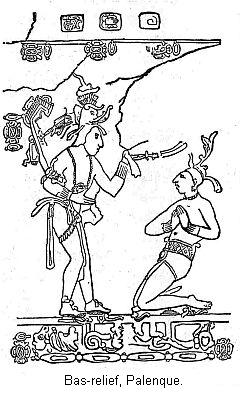
Our general view, taken from Mr. Stephens's
works, represents the ruined eastern front of this building,
surmounting the pyramid. Trees are seen growing all over the
ruins. The outer wall is pierced by numerous doorways which,
being somewhat wider than the space that separates them, gives to
the whole the appearance of a portico with wide piers: no remains
of the doors themselves have been discovered. Drilled holes in
the projecting cornice, immediately above the doorway, gave Mr.
Stephens the impression that an immense cotton curtain, perhaps
painted in a style corresponding with the ornaments, had been
extended the whole front, which was raised or lowered, according
to the weather. The lintels of the doors were of wood. They had
long since vanished, and the stones over the doorway fallen down.
Of the piers separating the doorways, only fifteen were found
standing, but the crumbling remains of the others were readily
traced on the ruins.
Each of the standing piers, and presumably all
the others, was ornamented with a bas-relief in stucco. This cut
gives us a good example of this style of ornamentation. We notice
portions of a richly ornamented border. This stucco work consists
of human figures in various attitudes, having a variety of dress,
ornaments, and insignia. The stucco is said to be nearly as hard
as the stone itself. Traces of paint, with which the figures were
once ornamented, were still to be seen. The conjectures in regard
to these figures, have been innumerable. Vividly painted, and
placed in a conspicuous place on the wall, we may be very sure
they were full of significance to the builders. Three
hieroglyphics are placed over the head of each group, but so far,
they are as little understood as the figures themselves. We can
imagine the effect, when the building was still perfect and
entire, and all the piers were thus ornamented.
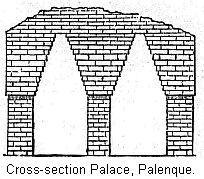
Passing to the top of the pyramid, we find the
construction of the building whose outer wall we have been
describing, to be substantially as follows: Three parallel walls,
from two to three feet in thickness, composed of hewn stones,
were erected about nine feet apart. At the height of ten feet,
the walls commenced approaching each other; not, however, in an
arch, for this was unknown, but in a triangular manner, the
stones in each course projecting a little farther out. This cut
represents a cross-section of the buildings, and shows also the
slight cornice. All inequalities in the surface, as here
represented, were then filled with cement, thus furnishing a
smooth surface, which was then painted. The two outer walls were
plentifully supplied with doorways; the central wall had but few.
We are only given the description of one, which may not apply to
all. This one, opposite the entrance on the east side, has a
trefoil-shaped arch over the door, thus giving it this shape.
Besides the few doorways, the central wall had numerous
depressions, or niches, some of which served for ventilation,
others for the support of beams, and perhaps others as
receptacles for torches or idols. This principle of construction
is substantially the same for all the buildings in the interior
of the court, and indeed for all the buildings at Palenque.

Passing through the doorway just described, we
come into the second corridor, and continuing through that, we
come to what was once a large court; but, as we stated, it was
subsequently built over so as to leave only a few courts. The
largest one, eighty by seventy feet, is immediately before us,
with a range of steps leading down into it. On each side of the
stairway is sculptured, on stucco, a row of grim and gigantic
figures. The engraving opposite represents the same. "They are
adorned with rich headdresses and necklaces, but their attitude
is that of pain and trouble. The design and anatomical
proportions of the figures are faulty, but there is a force of
expression about them which shows the skill and conceptive force
of the artist." From this small court stairways lead to the other
buildings situated around it.

Stucco ornaments were plentiful. In one room,
rather more richly ornamented than the others, was found a stone
tablet, which is the only important piece of stone sculpture
about the palace. We are told it is of hard stone, four feet long
by three feet wide, and the sculpture is in bas-relief. It is set
in the wall, and around it are the remains of a rich stucco
border. Its significance is unknown. We must notice the small
medallion, containing a face, suspended by a necklace of pearls
from the neck of the principal figure. Mr. Stephens conjectures
that it may represent the sun. Mr. Waldeck gives a drawing of
this same subject; but instead of a face, he represents a
cross.13
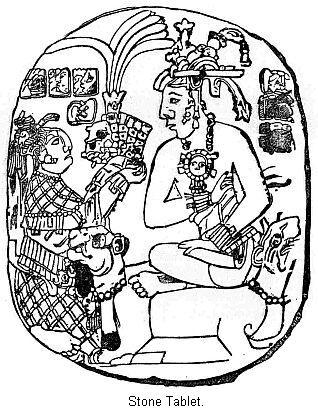
In the general view we see a tower rising up
from the mass of ruins. Mr. Stephens speaks of this tower as
follows. "This tower is conspicuous by its height and
proportions, but an examination in detail is found unsatisfactory
and uninteresting. The base is thirty feet square, and it has
three stories. Entering over a heap of rubbish at the base, we
found within another tower distinct from the outer one, and a
stone staircase, so narrow that a large man could not ascend it.
The staircase terminated against a dead stone ceiling, closing
all further passages, the last step being only six or eight
inches from it. For what purpose a staircase was carried up to
such a bootless termination we could not conjecture. The whole
tower was a substantial stone structure, and in its arrangements
and purposes about as incomprehensible as the sculptured
tablets."
At the best we can do, it is hard to give such
a description of this ruin that it can be readily understood, so
we will present a restoration of it by a German artist,14 taken, however, from Mr. Bancroft's
work.15 This is very useful to
us, since it conveys an idea of how the palace looked when it was
complete. This view also includes a second structure, which we
will examine soon. We notice the numerous doorways leading into
the first corridor, the ornamental pier-like portions of the wall
separating the doors, and the several buildings on the court;
rising over all, the tower, which would have been better if the
spire had been omitted.
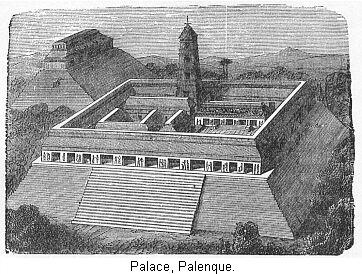
This may have been a real palace. Its rooms
may have been the habitations of royalty, and its corridors may
have resounded with the tread of noble personages. M. Charney
thinks the palace must have been the home of priests, and not
kings—in fact, that it was a monastery, where the priests
lived who ministered in the neighboring temples. He thinks
Palenque was a holy place, a prehistoric Mecca. We must be
cautious about accepting any theory until scholars are more
agreed about the plan of government and society among the Central
American tribes. But, whatever it was, many years have passed by
since it was deserted. For centuries tropical storms have beat
against the stuccoed figures. The court-yards and corridors are
overrun with vegetation, and great trees are growing on the very
top of the tower. So complete is the ruin that it is with
difficulty the plan can be made out. The traveler, as he gazes
upon it, can scarcely resist letting fancy restore the scene as
it was before the hand of ruin had swept over it. In imagination
he beholds it perfect in its amplitude and rich decoration, and
occupied by the strange people whose portraits and figures may
perhaps adorn its walls.
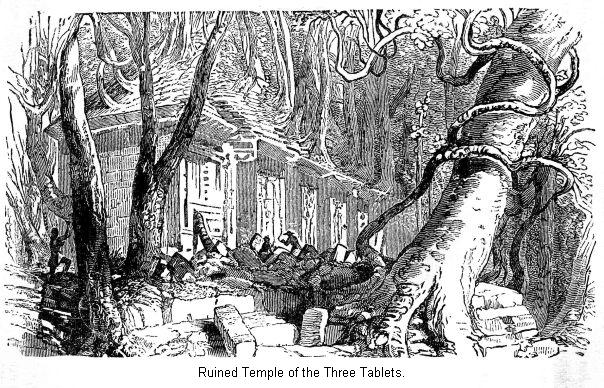
We must now describe the more important of the
remaining structures of Palenque. Glancing at the plan for a
moment, we see to the south-west of the palace a ruin marked 2.
This is the site of a pyramidal structure known as the "Temple of
the Three Tablets," or "Temple of Inscriptions." The pyramid is
not as large in area as the palace, though of a greater height.
It measures in height one hundred and ten feet on the slope, but
we are not given the other dimensions. All the sides, which were
very steep, seem to have had steps. Trees have grown up all over
the pyramid and on the top of the building. This illustration,
taken from Mr. Stephens's work, can not fail to impress on us the
luxuriant growth of tropical vegetation, and we can also see how
such a growth must accelerate the ruin. The stone steps leading
up the sides of the pyramid have been thrown down, and such must
be in time the fate of the building itself. The building on the
summit platform does not cover all the area. It is seventy-six
feet front by twenty-five feet deep and about thirty-five feet
high.
This small cut is a representation of the same
building on a small scale, but cleared of trees and vines. The
roof is seen to consist of two parts, sloping at different
angles. The lower part was covered with stucco ornaments, which,
though too much injured to be drawn, gave the impression that,
when perfect and painted, they must have been rich and imposing.
The upper slope is of solid masonry. "Along the top was a range
of pillars, eighteen inches high and twelve apart, made of small
pieces of stone laid in mortar and covered with stucco, having
somewhat the appearance of a low, open balustrade."

In this wood-cut the front wall, as in the
palace, presents more the appearance of a row of piers than any
thing else. Each of the corner piers contains on its surface
hieroglyphics, each of which contains ninety-six squares. The
other piers have ornaments of stucco similar to those we have
already examined on the palace. In the building itself we have
the usual three parallel walls. In this case, however, the second
corridor is divided into three rooms, and there is no opening in
the third wall, unless it be three small openings for air. The
central wall is four or five feet thick.16 The interior is very plain.
The principal point of interest about the
building, from whence the name is derived, is three tablets of
hieroglyphics. One on either side of the principal doorway of the
middle wall, and the third in the rear wall of the middle room.
Being so similar to other tablets, it is not necessary to give
separate cuts of them. The similarity to those of Copan is very
great, the differences being in minute points, which only
critical examination would detect. Mr. Stephens tells us that the
Indians call this building a school. The priests who came to
visit him at the ruins called it a temple of justice, and said
the tablets contained the law. We do not think either are very
safe guides to follow.
At number three on the plan are the ruins of
an edifice which is fast disappearing. The outer wall had already
fallen at the time of Mr. Stephens's visit. It stands on the bank
of the stream. The pyramid base is one hundred feet high on the
slope. The building on the top is twenty-five feet front by
eighteen feet deep. In the inner corridor could be dimly traced
the outlines of a beautiful piece of stucco work. At the time of
Waldeck's visit it was still complete, so we are enabled to give
a cut of it.
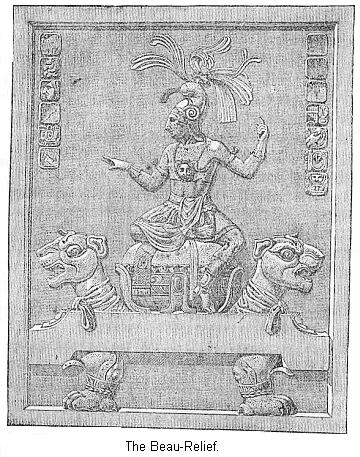
We are sure the readers will not fail to
notice the many points which make this such an exceptionally fine
piece of work. In the original drawing the grace of the arms and
wrists is truly matchless, and the chest muscles are displayed in
the most perfect manner. The embroidered girdle and folded
drapery of the figure, as well as the drapery around the
leopard's neck, are arranged with taste. The head-dress is not
unlike a Roman helmet in front, with the addition of numerous
plumes. The sandals of the feet are secured by a cord and
rosette, while the ornaments on the animal's ankles seem secured
by leather straps.17 Mr. Waldeck,
however, who drew this sketch, is supposed to have drawn at times
better than his model.18 This is
generally called the "Temple of the Beau-relief." Mr. Holden, in
his able article already referred to, comes to the conclusion
that this figure represents the god Quetzalcohuatl, the nature
god of the Mayas.

Eastward from the palace, and across the
creek, are seen on the plan the location of two other structures.
The one marked is a somewhat famous structure, which, for reasons
that will soon appear, is called the "Temple of the Cross." The
pyramid in this case is one hundred and thirty-four feet on the
slope. It, however, stands on a terrace about sixty feet on the
slope. The forest is so dense that, though other structures are
but a short distance from it, yet they can not be seen. The last
two engravings represent the building and the ground plan. This
is not a fanciful sketch, but is a restoration, "from such
remains and indications that it is impossible to make any thing
else out of it."

"The building is fifty feet front, thirty-one
feet deep, and has three door-ways. The whole front was covered
with stucco ornaments. The two outer piers contain
hieroglyphics." We notice a new feature about the roof. It is
similar to the roof of the temple of the "Three Tablets," in
having two different slopes—the lower one covered with
stucco ornaments, but the range of pillars along the roof is here
replaced by a peculiar two-storied arrangement nearly sixteen
feet high. Mr. Stephens says: "The long sides of this narrow
structure are of open stucco-work, formed into curious and
indescribable devices, human figures with legs and arms spreading
and apertures between, and the whole was once loaded with rich
and elegant ornaments in stucco relief. Its appearance at a
distance must have been that of a high, fanciful lattice. It was
perfectly unique—different from the works of any other
people with which we are familiar, and its uses and purposes
entirely incomprehensible."
It was evidently added to the temple solely
for the sake of appearance. One writer19 believes the roof structures were
erected by some people that succeeded the original builders of
the temple. The plan of the temple gives us a clear idea of the
arrangement of the inner rooms. Our principal interest centers in
the altar, which we notice placed in the center of the back room.
We give an illustration of a similar altar-form in the temple, at
number 5 of the plan. In form it is that of an inclosed chamber,
having a roof of its own. The altar in the Temple of the Cross
was very similar to this. Mr. Stephens's description is as
follows: "The top of the doorway was gorgeous with stuccoed
ornaments, and on the piers at each side were stone tablets in
bas-relief. Within, the chamber is thirteen feet wide and seven
feet deep."
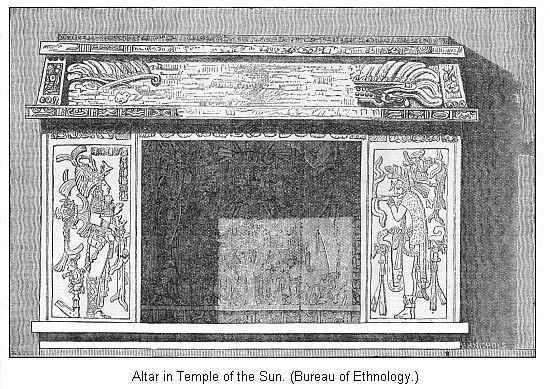
The room was plain within, and right against
the back was the famous "Tablet of the Cross." This tablet was
six feet four inches high, ten feet eight inches wide, and formed
of three stones. The right-hand one is now in the National Museum
in Washington. The central one, though torn from its original
place, is still at the ruins. The next cut gives us only the
sculptured part of the tablet. On both the right and left-hand
were tablets of hieroglyphics. A long chain of ornaments hung
suspended from the cap of the right-hand figure. The two figures
are regarded as priests. The cross is very plainly outlined, and
is the regular Latin one. Considerable discussion has arisen as
to what supports the cross. Dr. Brinton thinks it a serpent.20 Others think it a human skull.21 We must also notice the bird on
top of the cross. It is almost impossible to make out the
species. The right-hand figure is offering it something.

We must refer to some more tablets found at
Palenque before proceeding further. At number five of the plan
was a temple but little smaller than the one just described.
There is, however, such a similarity between the buildings, that
it is not necessary to give illustrations. The temple, also, had
an inclosed altar; and against the back of that was placed the
tablet which was very similar to the one just described. This
illustration represents the sculptured portions. On each side
were tablets of hieroglyphics. It needs but a glance to show that
the priests are, evidently, the same personages as in the other
tablet.

The one on the left is standing on the back of
a human being. The one on the right is, perhaps, standing on a
beast; or, if a human being, he is crushed beneath the weight of
the priest. Two other human figures support a platform, from
which rise two bâtons crossed like a St. Andrew's cross.
These support a mask, from the center of which a hideous human
face looks out. The Aztecs sometimes represented the sun by such
a mask, and hence the name "Temple of the Sun."
In still another temple, situated but a short
distance from the others, was discovered a third tablet, which is
shown in the cut opposite. We give all the tablet, showing the
hieroglyphics as well. We must compare this with the first tablet
given. The priests are, evidently, the same—but, notice,
they stand on different sides of the cross. The same priest is
making the offering as in the first, and the same bird is seen on
the top of the cross. The priests stand on flowered ornaments.
The support of the cross resembles the same thing as in the first
but whether it is a human skull, or a serpent, is hard to tell.
The cross itself is not as well outlined. The two arms are floral
ornaments. We must also notice the two faces seen on the upright
part.22
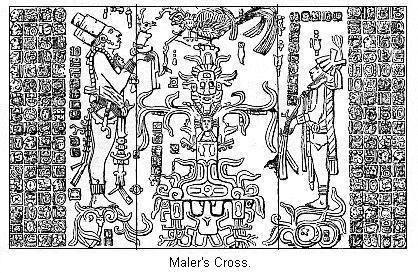
These tablets are all of great interest. That
of the cross, the first one given, has attracted more attention
than almost any other in the field of American antiquities. This
is largely owing to the cross. As far as the sacred emblem itself
is concerned, we do not think this tablet of more significance
than that of the sun. It is well known that the cross, as a
sacred emblem, had peculiar significance in the ancient religions
of the world. Its use as such has come down to us from time
immemorial. On the first expedition of the Spaniards, in 1518, to
the coast and islands of Yucatan, they discovered that the cross
was of some significance to the natives. In the island of Cozumel
they found a large cross, to which the natives prayed for rain.23
Mr. Brinton thinks that the source of this
veneration of the cross, like the the sacredness of the number
four, of which he gives numerous illustrations, is the four
cardinal points.24 From these
points blow the four winds which bring the fertilizing rains, and
thus render the earth fruitful; and hence the cross, in so many
and widely separated portions of the earth, is used as the symbol
of the life-giving, creative, and fertilizing principle in
nature.25 He thinks this is,
perhaps, the significance of these Palenque crosses. It is true
we have different forms of the cross; but in ancient sculpture
they seem to have been of equal importance.26
The results of these inquiries into the hidden
meaning of these tablets are not devoid of interest; but, thus
far, but few conclusions of value have been obtained. They have
been made to do service in support of some far-fetched theories.
The early Spanish writers on these subjects concluded that the
crosses found in Central America were positive proof that St.
Thomas had traveled through the country preaching the doctrines
of Christianity. The padres, who came to visit Mr. Stephens at
the ruins, "at the sight of it, immediately decided that the old
inhabitants of Palenque were Christians, and fixed the age of the
buildings in the third century."
Wilson finds in the tablets of the cross a
strong argument for the existence of a great Phœnician
empire in Central America. This tablet represents, he thinks, the
sacrifice of a child to Astarte,27 also called Ashtoreth, the great
female deity of the ancient Semitic nations on both sides of the
Euphrates, but chiefly of Phœnicia. The original meaning of
this word was "Queen of Heaven." Modern scholars do not think
these early speculations of the slightest worth. Dr. Charles
Rau28 concludes that as
reasonable a conjecture as any is the supposition that it
represents a sacrifice to the god of rain, made, perhaps, at a
time of drought, apparently influenced to that conclusion by the
fact that the natives of Cozumel regarded a cross in such a
light,29 and further that a cross
represents the moisture-bearing winds.
E. S. Holden30
has made a critical study of the hieroglyphics of Copan and
Palenque. Though far from complete, most interesting results have
been obtained. We can not do more than set forth the results of
his investigations.31 He
concludes, from a careful study of the tablets of the cross and
of the sun, that in both the left-hand priests are
representatives of the god of war,32 the right-hand priests being in both
representatives of the god of rain and water.33 In Mexico these deities frequently
occupied the same temple.34 He
does not state his conclusions in regard to the central figures
in the tablets. Mr. Brinton thinks the central figure in the
tablet of the cross is a rebus for the nature god Quetzalcohuatl.
The cross was one of the symbols of Quetzalcohuatl, as such
signifying the four winds of which he was lord. Another of his
symbols was a bird. We notice the two symbols present in the
tablet. Mr. Holden also finds that the glyph standing for this
god occurs several times in the tables of hieroglyphics belonging
to this figure.
According to these last views, then, the old
Palenquians seem to have been a very religious people, and
Quetzalcohuatl, the god of peace, seems to have been their
principal deity, differing in this regard from Mexico, where all
honor was paid to the god of war. We are not given any
explanation of the Temple of the Three Tablets, but the other
temples have to do with the worship of this benign deity. The
beautiful stucco-work in the Temple of the Beau-relief, Mr.
Holden thinks, also represents him. At the Temples of the Cross,
if we be right as to the meaning of the central figure, the
priests of the god of war and the god of rain do honor to him.35
Mr. Bandelier makes a statement in regard to
the cross which, if it be accepted, clears away a number of
theories. He remarks: "The cross, though frequently used
previously to the conquest by the Aborigines of Mexico and
Central America as an ornament, was not at all an object of
worship among them. Besides, there is a vast difference between
the cross and the crucifix. What has been taken for the latter on
sculptures, like the 'Palenque tablet,' is merely the symbol of
the 'Newfire,' or close of a period of fifty-two years. It is the
fire drill more or less ornamented." According to this view,
these interesting tablets have reference to the ceremonies
observed by the Mayas at the expiration of a cycle.36
It now only remains to describe some
miscellaneous relics obtained from Palenque. But few specimens of
pottery have been found. One of the early explorers speaks of
finding an earthen vessel about a foot in diameter. Waldeck made
an exploration in a portion of the palace area, and found a
gallery containing hewn blocks of stone and earthen cups and
vases, with many little earthen balls of different colors. He
also speaks of a fine specimen of terra-cotta.37
The only statues known were found near the
Temple of the Cross. There were two of them, and they supported a
platform before the central doorway. One was broken to pieces;
the other is here represented. Many writers point out
resemblances between this figure and some Egyptian statues.

In the village of Palenque, built in the wall
of a church,38 are two stone
tablets which once stood on each side of the doorway of the altar
containing the tablet of the cross.39 Mr. Stephens was under the impression
that they were originally placed on the altar of the tablet of
the sun, and they are so represented in the cut (Altar in the Temple of the Sun.)
earlier. This plate represents the left-hand figure. The only
explanation which we have met is contained in that oft-quoted
article by Mr. Holden. He regards it as the representation of the
Maya god of war. We are warned that the weak part of Mr. Holden's
method is his assumption that the mythology of the Mayas was the
same as that of the Aztecs, when the evidence is not strong
enough to assert such a fact.40
We feel that we have been somewhat lengthy in
describing the ruins of Palenque. But it is one of the most
important groups of ruins that this continent possesses. The most
faithful work on the part of the scholars of all lands has not as
yet succeeded in clearing up the mystery connected with it. We
can tread the courts of their ancient citadel, clamber up to the
ruined temples and altars, and gaze on the unread hieroglyphics,
but, with all our efforts, we know but little of its history.
There was a time when the forest did not entwine these ruins.
Once unknown priests ministered at these altars. But cacique, or
king, and priest have alike passed away. The nation, if such it
was, has vanished, and their descendants are probably to be found
in the savage tribes of Yucatan to-day. "In the romance of the
world's history," says Mr. Stephens, "nothing ever impressed me
more forcibly than the spectacle of this once great and lovely
city, overturned, desolate, and lost, discovered by accident,
overgrown with trees for miles around, without even a name to
distinguish it. Apart from every thing else, it was a mournful
witness to the world's mutation.
"'Nations melt
From power's high pinnacle, when they have felt
The sunshine for awhile, and downward go.'"
The ruins at Palenque have been so well known,
that but little attention has been given to other ruins in the
States of Tobasco and Chiapas; and yet, according to M. Charney,
imposing ruins of great extent exist in the western part of
Tobasco. At a place about thirty-five miles from San Juan, in a
north-westerly direction, he found veritable mountains of ruins
"overgrown with a luxuriant vegetation."41 In the absence of cuts, we can not do
more than give a general idea of these ruins.
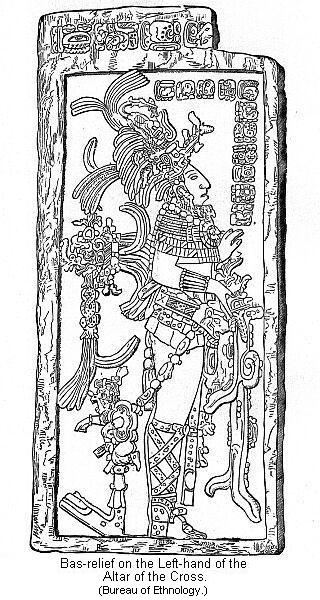
He asserts that the whole State of Tobasco,
and part of Chiapas, is covered with ruins. One landed proprietor
informed him that, on his estate, he had counted over three
hundred pyramids, all of them covered with ruins. In this
connection he refers to the assertions of some of the early
Spanish voyagers, that, when skirting the shores of Tobasco, they
"saw on the shore, and far in the interior, a multitude of
structures, whose white and polished walls glittered in the sun."
On one large pyramid, one hundred and fifteen feet high, he found
the remains of a building two hundred and thirty-five feet
long.
This building is named the palace. In this
building we met with the type that we have learned is the
prevailing one further south—that is, three parallel walls,
forming two rows of rooms. In general, the rooms are not well
arranged for comfort, according to our opinion; but they were,
doubtless, well adapted to the communal mode of life prevalent
among the Indians. M. Charney seems to have been strongly
impressed with the number and importance of the ruins in this
State; but, strangely enough, others have not mentioned them.42 He says: "I am daily receiving
information about the ruins scattered all over the State of
Tobasco, hidden in the forests. . . . The imagination fails to
realize the vast amount of labor it would involve to explore even
a tithe of these ancient sites. These mountains of ruins extend
over twelve miles. We still see the hollows in the ground whence
the soil was taken for the construction of these pyramids. But
they did not consist merely of clay; bricks, too, entered into
their construction, and there were strengthening walls to make
them firmer. These structures are more wonderful than the
pyramids and the other works at Teotihuacan, and they far surpass
the pyramids of Egypt."
In the neighboring State of Chiapas, we find
the location of several groups of ruins. At Ocosingo, we have the
evident traces of a large settlement. Mr. Stephens mentions four
or five pyramids crowned with buildings. Immediately beyond these
pyramids he came upon an open plateau, which he considered to
have been the site of the city proper. It was protected on all
sides by the same high terraces, overlooking for a great distance
the whole country around, and rendering it impossible for an
enemy to approach from any quarter without being discovered.
"Across this table was a high and narrow causeway, which seemed
partly natural and partly artificial, and at some distance on
which was a mound, with the foundation of a building that had
probably been a tower. Beyond this the causeway extended till it
joined a range of mountains. . . . There was no place we had seen
which gave us such an idea of the vastness of the works erected
by the aboriginal inhabitants."43
The ruins at Palenque are considered by some
to belong to the ancient period of Maya architecture; those we
are now to examine are regarded as of more modern date. This is
at least true with respect to the time of their abandonment.
Though the efforts of explorers in Yucatan have been attended
with rich results, still few places have been fully described.
The country is fairly dotted with sites of aboriginal
settlements. In all probability there are many that are yet
unknown. Hidden in tropical jungles, they are fast falling into
meaningless mounds of débris. The early Spanish
explorers, skirting the coasts of Yucatan, gazed in astonishment
at the views they occasionally obtained of pyramids crowned with
temples and imposing buildings. But this gleam of historic light
was but momentary in duration. It served but to throw a sunset
glow over the doomed tribes and civilization of the Mayas. By the
aid of that dim, uncertain light, we are asked to recognize a
form of government and society which, under the clearer light of
modern researches is seen to bear an equally strong resemblance
to institutions more in keeping with the genius of the New
World.
The few travelers who visit the country are
generally content to revisit and describe places already known.
This is not strange, considering the difficulties that have to be
overcome. The country swarms with savage Indians, who are jealous
of the intrusions of strangers. We have, however, this
consolation: those ruins already brought to light show such a
uniformity of detail, that it is not probable that any new
developments are to be expected. The ruins that are already known
are sufficient to illustrate all the points of their
architecture; and we can draw from them, doubtless, all that can
be drawn from ruins, throwing light on the civil organization of
the Mayas of Yucatan.
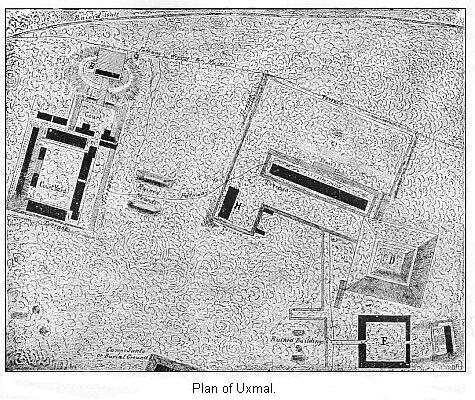
We can not do better than to describe some of
the more important ruins, and then notice wherein others differ.
Examining the map, we see that Uxmal44 is one of the first ruins that would
meet us on arriving, in the country. It is more fully described
than any other, though perhaps not of greater importance than
those of some other localities. As at Palenqué, while the
principal ruins are said to be situated in a small area, the
whole section abounds in mounds and heaps of
débris, and it may well be said that buildings as
imposing as those already described are concealed in the forest
not far removed from the present ruins. A plat of ground
seventeen hundred feet long by twelve hundred feet wide would
include the principal structures now known.
The most imposing single edifice here is that
called the Governor's House. The only reason for giving it this
name is its size. Being of large size, and located on a terraced
pyramid, it has received a name which may be very inappropriate.
We will first notice the pyramid on which the building stands. At
Palenque the pyramid rises regularly from the ground. Here the
pyramid is terraced. In order to understand clearly the
arrangement of these various terraces, we introduce this drawing.
The base is a somewhat irregular figure, though nearly a square.
Another pyramid cuts into one corner of the terrace. The first
terrace is about three feet high, fifteen feet broad, and five
hundred and seventy-five feet long. The second terrace is twenty
feet high, two hundred and fifty feet wide, and five hundred and
forty-five feet in length. The third terrace, on which the
building stands, is nineteen feet high, and its summit platform
is one hundred by three hundred and sixty feet. The height of
this platform above the general surface is a little over forty
feet.45

The material of which the pyramid is composed,
is rough fragments of limestone, thrown together without order;
but the terraces were all faced with substantial stone work. At
the time of Mr. Stephens's visit the facing of the second terrace
was still in a good state of preservation. Charney believes the
platform was paved with square blocks. This pyramid was not
entirely artificial—they took advantage of a natural hill,
as far as it went. No stairway or other means of ascent to the
first terrace is mentioned. From its low height, probably none
was needed. The second terrace being twenty feet high, some means
of ascent was required. This was afforded, as seen in the
drawing, by an inclined plane, at the south side one hundred feet
broad. From the second terrace a grand staircase, one hundred and
thirty feet wide, containing thirty-five steps, led up to the
summit of the third terrace.
No buildings or other ornaments are mentioned
as having been found on the lower terrace. The wide promenade of
the second one supported some structures of its own, but they
were in too dilapidated a condition to furnish a clear idea of
their original nature, except in one instance—that is of
the building at A of the drawing. This building was ninety-four
feet long, thirty-four feet wide, and about twenty feet high.
The roof had fallen in, so that we do not know
the arrangement of the rooms in the interior. The simplicity of
ornaments on the outer wall is commented on. Instead of the
complicated ornaments, so apparent on the buildings of Yucatan,
the only ornament in this case was a simple and elegant line of
round columns, standing close together, and encircling the whole
edifice. At regular intervals on the upper cornice appeared a
sculptured turtle. From this circumstance, the building was named
"The House of Turtles." No steps lead to the terrace below or to
the one above. "It stands isolated and alone, seeming to mourn
over its own desolate and ruinous condition."
At B, along the south end of the terrace,
there was a long, low mound of ruins, and arranged along its base
was a row of broken columns about five feet high and nearly five
feet in circumference. Some have supposed, from this, that
columns extended along the entire promenade of the second
terrace. This would indeed give it a very grand appearance; but
there is no foundation for such a view. East of the central
stairway at C, was a low, square inclosure. This contained a
standing pillar, now in a slanting position, as if an effort had
been made to throw it over. It was about eight feet above the
surface of the ground and five below. The Indians called it a
whipping-post. Mr. Stephens thinks it was connected with the
ceremonial rites of an ancient worship. He found a similarly
shaped stone in connection with other buildings at Uxmal, and at
other places in Yucatan.
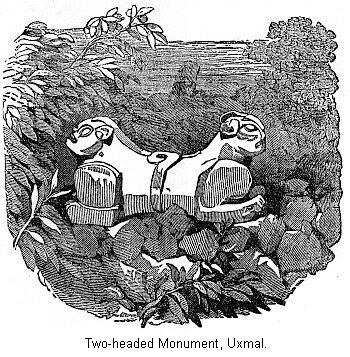
Still further east, at D, he found a rude,
circular mound of rough stones. On excavating this, he was
rewarded by the discovery of a double-headed monument. It was
carved out of a single block of stone. The probabilities are that
it was purposely buried when the natives abandoned Uxmal, to
prevent the Spaniards from destroying it. Scattered about over
this platform were found excavations much like well-made cisterns
in shape. As it is something of a mystery where the inhabitants
obtained water, it is a reasonable supposition that these were
really cisterns. Similar excavations were discovered all over the
area of the ruins.
Leaving the second terrace, and passing up the
ruined stairway, we find ourselves on the summit platform of the
third terrace, and see before us one of the long, low, richly
ornamented buildings of Yucatan. This cut presents us an end
view, but gives us a good idea of the building as a whole. It
does not occupy the entire summit; there is a wide promenade all
around it. Its length is three hundred and twenty-two feet; its
width, thirty-nine feet, and its height twenty-six feet.

In order to understand clearly the arrangement
of the rooms, we will here give the ground-plan. The two end
portions may have been additions to the original structure. There
are, at any rate, reasons for supposing the small rooms in the
two recesses of later construction. We must notice that we have
here the usual three parallel walls and two rows of rooms. All
the walls are massive, the rear wall especially so. It is nine
feet thick throughout, and so are the transverse walls of the two
recesses. Supposing the rear wall might contain rooms, Mr.
Stephens made an opening through it. He found it to be solid.

The stones facing the walls and rooms are
smooth and square, and the mass of the masonry consists of rough,
irregular fragments of stone and mortar. This cross-section makes
this meaning plain. We can but notice what an immense amount of
useless labor was bestowed on the walls and ceilings of this
building. We gather more the idea of galleries excavated in a
rocky mass, than of rooms inclosed by walls. The rooms are very
plain; no attempt at decoration was observed. In one or two
instances the remains of a fine coat of plastering was noticed.
"The floors were of cement, in some places hard, but by long
exposure broken, and now crumbling under foot." The arches
supporting the roof are of the same style as those at
Palenque—that is, triangular,—though, in this case,
the ends of the projecting stones were beveled off so as to form
a smooth surface. At Palenque, we remember, the inequalities were
filled with cement. Across the arches were still to be observed
beams of wood, the ends buried in the wall at both sides. The
supposition is that they served to support the arches while
building, and afterwards for the suspension of hammocks.46
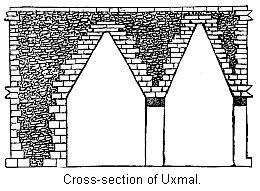
There are no openings for light and
ventilation, consequently some of the rear rooms are both damp
and dark. The lintels over each doorway were of wood. This was
the common and ordinary material employed for lintels in Yucatan,
though in one or two instances stone was used. They used for this
purpose beams of zapote, a wood noted for its strength and
durability. Some inner lintels still remain in place. The one
over the central doorway of the outer wall was elaborately
carved, the others were plain.
The outside of the building is also of
interest to us. By a careful examination, we notice a cornice
just above the doorway. The wall below the cornice presents a
smooth surface of limestone, no traces of plaster or paint
appearing; above the cornice the façade is one solid mass
of rich, complicated, and elaborately sculptured ornaments. This
is not stucco work, as at Palenque, but the ornaments are carved
on stone. Mr Stephens tells us, "Every ornament or combination is
made up of separate stones, each of which had carved on it part
of the subject, and was then set in its place in the wall. Each
stone, by itself, is an unmeaning fractional portion, but placed
by the side of others, makes, part of a whole which, without it,
would be incomplete."
It is not possible to give a verbal
description of all of the ornaments; we can notice but few. Over
each doorway was represented a person apparently seated on a sort
of throne, having a lofty head-dress, with enormous plumes of
feathers falling symmetrically on each side. Though the figures
varied in each case, in general characteristics they were the
same as the one here represented, which was the figure over the
central doorway of the building.
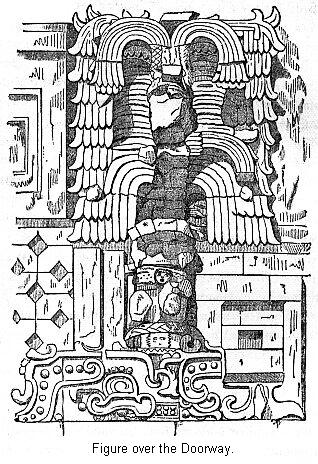

Among the most commonly reappearing ornaments
at Uxmal, and at other places, is one that has received the name
of the "Elephant's Trunk," and has given rise to no little
discussion. One occurs immediately above the figure. Part of this
ornament is represented in this plate. The central part of this
figure, which appears as a plain band, is in reality a curved
projecting stone, which, when looked at sideways, has the
appearance given in this cut. Though requiring a little
imagination, the majority of travelers see in this some monster's
face. The eyes and teeth are seen in the first engraving. This
projecting stone is the nose.

We stand in amazement before this sculptured
façade. We must reflect that its builders were not
possessed of metallic tools. It extends entirely around the
building, though the end and rear walls are not as elaborately
decorated as the front. A little calculation shows that it
contains over ten thousand square feet of carved stone. The roof
of the building was flat. It had been covered with cement. But
vegetation had somehow acquired a foothold, and the whole is now
overgrown with grass and bushes. Such is a brief description of
this "casa." Hastening to ruins, it appeals powerfully to the
imagination. It is a memorial of vanished times. We wonder what
of the strange people that pressed up these stairs and entered
these rooms? For many years it has been abandoned to the
elements. Year by year portions of the ornamented façade
fall. Though the walls are massive and the roof is strong, it is
but a question of time when a low mound of ruins will alone mark
its site.
Like the palace at Palenque, this structure
has given rise to conflicting theories as to its use. While many
of the writers on this subject claim that it was the residence of
royalty, there are, on the other hand, those who think it is
simply a communal house of village Indians, or the official house
of the tribe. In whatever light we shall ultimately view it, it
is surely an interesting monument of native American culture. The
labor necessary to rear the terraced pyramid, even though
advantage was taken of a natural eminence, must have been great.
The building itself, though not of great dimensions, except in
length, must have required the labor of a large number of Indians
for a long time. For purposes of defense, the location, from an
Indian point of view, was an excellent one, since with them
elevation constitutes the principal means of defense. The
terraces could be easily ascended from but one point, where an
enemy could be easily resisted. In a general way, it may be
regarded as a representative of Yucatan buildings, and so we will
be able to more rapidly describe the remaining structures.

On the general plan we see, to the north of
the structure we have just described, a group of ruins marked
"C." This is regarded as the most wonderful collection of
edifices in Yucatan, and as exhibiting the highest state of
ancient architecture and sculpture in North America. They are
known as the "Nunnery," which we think is a very absurd name. The
pyramid on which they stood is also terraced, though on one side
only. We give a drawing showing the position on the summit
platform of the four buildings forming this group. Since we have
so many ruined structures to describe, we must avoid such details
as will prove tiresome. We will give in a note the dimensions of
these buildings, and of the pyramid, and pass at once to some
points of special interest.47
Traces of stairways are mentioned as leading
up to the terrace, but none of the steps remained in place. The
southern building is seen to have doors in both the court and
terrace walls, but in this case the middle wall is unbroken. All
the rooms of this building are single. In the plan it appears
divided into two buildings; the opening is, however, but a
triangular arched doorway, through which access was had to the
court.
There is no one to dispute our right of way,
and so, climbing up the ruined stairs, and passing through the
deserted gateway, we emerge into a courtyard, now silent and
deserted and overgrown with bushes and grass. It was once paved
and covered with cement, and in the center are the remains of a
stone pillar, similar to that in front of the governor's house.
When the houses were all occupied this court must have presented
an animated scene. But, now that the buildings are tenantless and
going to ruin, it must impress all beholders with a sense of the
changes wrought by time.
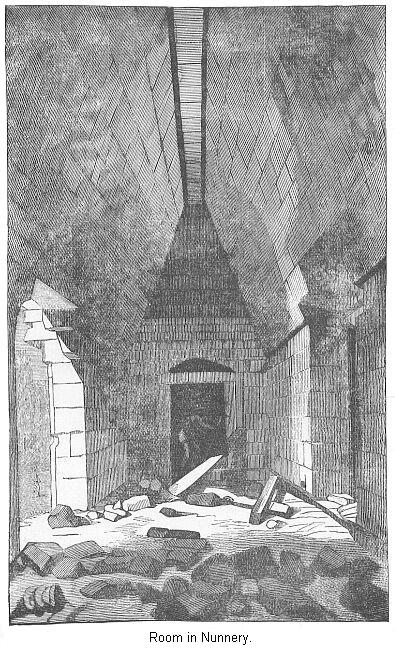
It will be noticed that the northern building
does not stand in quite the same direction as the southern one,
which detracts from the symmetry of the whole. It stands on a
fourth terrace, twenty feet higher than the others. A grand, but
ruined, staircase leads up the center of the terrace. At each end
of this staircase built against the terrace, could be
distinguished the ruins of a small building. There is one unusual
feature about the ruins in the eastern building. In general, only
two rooms open into each other. In this building, however, six
rooms form one suite, and, furthermore, all the doorways of this
suite are decorated with sculpture. As this suite of rooms was
evidently a place of interest, we will introduce this
illustration, which gives us a good idea of the appearance of the
rooms on the inside. We would do well to compare this cut with
that of the room in Pueblo
Bonito. The arched roof is not a true arch but simply the
triangular arch we have already spoken of.
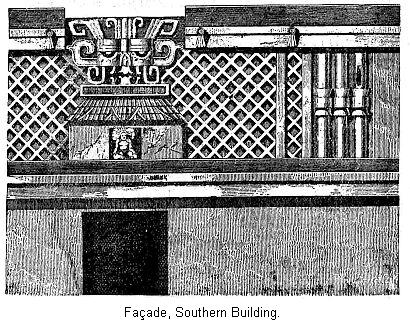
The principal attraction about these buildings
is the beautiful façades which overlook the court-yard.
They are pronounced by all to be the finest examples of native
American art. With one exception, they are neither complicated
nor grotesque, but chaste and artistic. As in the Governor's
House, the part below the cornice is plain, but the remaining
part, both front and rear, is covered with sculpture. On entering
the court-yard from the arched gateway of the southern building,
we notice that its façade is composed of diamond
lattice-work and vertical columns, while over each doorway is
something that resembles a house, with a human figure seated in a
doorway. This cut represents but a small portion of this
façade, but it gives us an idea of the whole.
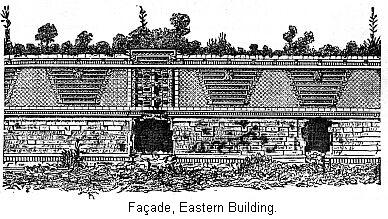
The façade of the eastern building was
in the best state of preservation of any. We give a section of
this also. The ornaments over the doorway, shown in the cut,
consist of three of those mysterious masks, with the projecting
curved stone, already described. "The ornaments over the other
doorways are less striking, more simple, and more pleasing. In
all of them there is, in the center, a masked face, with the
tongue hanging out, surmounted by an elaborate head-dress.
Between the horizontal bars is a range of diamond-shaped
ornaments, in which the remains of red paint are still distinctly
visible, and at each end of these bars is a serpent's head, with
the mouth wide open." It is necessary to examine the drawing
attentively, to distinguish these features. Some think the masked
face represents the sun.

The western façade is known as the
Serpent Façade. It was very much in ruins at the time of
Mr. Stephens's visit. When entire, it must have been of great
beauty. Two serpents are trailed along the whole front, and by
the interlacing of their bodies divide the surface into square
panels. In the open mouth of these serpents is sculptured a human
head. The panels are filled with ornaments similar in design to
those of the "Governor's House," and among the ornaments of each
panel are found one or more human faces, while full-sized figures
are not entirely absent. This cut represents but a small portion
of the façade. It gives us, however, an idea of the whole.
We notice, over the doorway again, the elephant's trunk
ornament.
The northern building, standing high above the
rest, on its own terrace, was doubtless intended to have the
grandest front of all. It was, however, in such a ruined state,
and the few remaining fragments so complicated, that no drawings
have been given us. Human figures are represented in several
places; two are apparently playing on musical instruments. We
recall that at Palenque, the roof of some of the temples bears a
curious two-storied work, erected apparently for ornamental
purposes. The same instinct reappears in this building. At
regular intervals along the front they carried the wall above the
cornice, forming thirteen turret-like elevations ten feet wide,
and seventeen feet high. These turrets were also loaded with
ornaments. Another curious feature about this building is, that
it was erected over, and completely inclosed, a smaller building
of an older date. Wherever the outer walls have fallen, the
ornamented cornice of the inner building is visible.
When we reflect on the patient labor that must
have been expended on this pyramid and these buildings, we are
filled with admiration for their perseverance and ingenuity. They
had neither domestic animals or metallic tools. The buildings
were massively built and richly ornamented. The sculptured
portion covers over twenty-four thousand square feet.48 The terraced mound supporting the
house contained over sixty thousand cubic yards of materials,
though this may not be wholly artificial. To our eyes, as these
rooms had neither windows nor fire-places, they are not very
desirable. But we may be sure that the builders considered them
as models of their kind.
Leaving this interesting ruin, we will now
visit one of the temples. This is east of the Nunnery, and is
marked "D" on the plan. The mound on which this building stands
is high enough to overlook the entire field of ruins. This cut
represents the eastern side of the mound, up which a flight of
stone steps lead to the building on the summit. There are some
grounds for supposing a grander staircase, supported on
triangular arches, led up the western side.
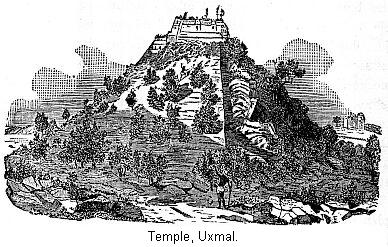
The building on the top is not
large—only seventy-two feet long, and twelve feet
wide—and consists of but three rooms, none opening into
each other. The front of the building, though much ruined,
presented an elegant and tasteful appearance. There seems to be
no doubt that this temple was the scene of idolatrous worship;
perhaps of human sacrifices. In a legal paper which Mr. Stephens
saw at Meridia, containing a grant of the lands on which these
ruins stand, bearing date 1673, it is expressly stated that the
Indians at that time had idols in these ancient buildings, to
which, every day, openly and publicly, they burned copal. Nor is
there any doubt that this was the continuation of an old custom.
In the end room of this temple are engraved two circular figures
which, by some, are considered as proofs of the presence of
Phallic worship.49
The buildings we have described will give us a
very good idea of the structures of this ancient city. We have
described but a few of them, but we have now only space to make
some general observations. We wish to point out some resemblances
to the ruins at Palenque. In both, buildings that served as
temples were not large, but of small dimensions, and contained
but few rooms. They occupy the summits of high pyramids. Such was
probably the building on the summit of the pyramid at "F" (see
plan). The buildings on the top of this pyramid, like that just
described, had but three rooms. A very large pyramid is seen at
"E." Our information in regard to it is very meager. A square
platform was found on the summit. It is not unreasonable to
suppose that this platform was intended to support a temple. But,
before it was erected, the presence of the Spaniards put an end
to all native building. There are, however, no proofs to be
advanced in support of this statement; it is a mere
suggestion.
We think the House of the Nuns illustrates the
general plan of building employed at both places. That is as
follows: They first erected a rectangular pyramid or mounds often
terraced. Buildings were then put up parallel to the four sides,
thus inclosing a court. At Palenque this court, as we have seen,
was built over. Besides the House of Nuns, there are several
other instances at Uxmal of courts with buildings on their sides.
Looking at the plan, we see one at "G," and a still more ruined
one between that and "F." Such a court, with traces of ruined
buildings, also exists between the nunnery and the temple, at
"D." It is not improbable that groups of low ruins existing to
the westward of the structures described would be found, on
examination, to reveal the same arrangements.
As for the grand terraced pyramid supporting
the Governor's House, it may well be that other buildings would
have been added in process of time, as population increased. It
is not necessary to suppose they erected all the buildings around
a court at once. It seems very reasonable to suppose the northern
building of the House of Nuns the oldest. The direction is not
quite the same as the others; it stands on a higher terrace; and,
furthermore, the present exterior walls are simply built around
the older building. It may be, however, that the great terraced
mound of the Governor's House was intended to support but one
building. As there is the best of reason for supposing that Uxmal
was inhabited at the time of the conquest, there is nothing to
forbid the conclusion that the erection of pyramids, temples, and
buildings was still going on.
Hieroglyphics, which formed such an
interesting feature at Palenque, are here almost entirely
wanting. A few rows occur around the head of the figure over the
principal doorway of the Governor's House. They are of the same
general character as those already described, but are "more rich,
elaborate, and complicated." As to the probable antiquity of
these ruins, we must defer consideration until we become more
acquainted with the ruins of Yucatan.
The places we have now described will make us
acquainted with the general character of the ruins scattered all
over Yucatan. We do not feel as if we would be justified in
dwelling at any great length over the remainder, though one or
two important places must be mentioned. A word as to the
frequency with which the ruins occur. We want to repeat that
Yucatan, even to this day, is far from being thoroughly explored.
Almost our only source of information is the writings of Mr.
Stephens. But he only described a few places. In a trip of
thirty-nine miles he took in a westerly direction from Uxmal he
saw no less than seven different groups of ruins. Some of these,
though in a very dilapidated state, presented points of great
interest. When he started he knew of but few of those ruins. Some
he heard of quite by accident while on his way, and some he first
saw as he journeyed along the road. We must suppose the whole
country equally well supplied.
After he had left Uxmal for good, at the
village of Nochahab (see map), a little inquiry brought him
information of so many ruins that he did not have time to visit
them all. As to the question of use to which these buildings were
applied, we must either suppose they had an immense number of
temples and palaces—one or the other every few
miles—or else they were the residences of the people
themselves. And, though it may seem very strange that an
imperfectly developed people should ornament so profusely and
delicately their ordinary places of abode,50 yet it is difficult to understand why
they should rear such an abundance of temples and palaces.
At Kabah (see map) Mr. Stephens found a most
interesting field of ruins, rivaling Uxmal in extent, if not
surpassing it. One group of buildings, arranged much like the
House of Nuns, has some interesting features about it. The
highest terrace in this case is nearly square, and the building
on its summit is nearly the same shape. We have here two rows of
double rooms, separated by a middle wall, very massive, as if two
of the typical Maya buildings had been placed back to back. The
front of this building was elaborately ornamented. In all the
buildings at Uxmal the part above the cornice only was
ornamented. Here the entire front was covered with carved stone.
To make room for further ornaments the roof bore an additional
appendage, like the second story of the Palenque temples. This
building must have presented a wonderful appearance when
entire.
Another feature at this place has reference to
the pyramid. We are familiar with the idea of a terraced mound
supporting buildings. In one of these Kabah structures the
buildings are arranged in a different and suggestive way. That
is, the pyramid was terraced off. There were three ranges of
buildings, the roof of one range forming a promenade in front of
the other. In another of the Kabah structures was found a wooden
lintel, elegantly carved. Mr. Stephens tells us the lines were
clear and distinct, and the cutting, under any test, and without
any reference to the people by whom it was executed, would be
considered as indicating great skill and proficiency in the art
of carving on wood. At the expense of a great deal of hard work,
he succeeded in getting this lintel out and removed to New York,
where it was unfortunately destroyed by fire.
They worked stone to better advantage at Kabah
than at Uxmal. For the first time we meet with lintels of stone
and a doorway with carved jambs. The lintels were supported in
the center by a pillar. The pillars were rude and unpolished, but
they were not out of proportion, and, in fact, were adapted to
the lowness of the building. We will only mention one more
structure. This is a lonely arch, of the same form as all the
rest, having a span of fourteen feet. It stands on a ruined
mound, disconnected from every other structure, in solitary
grandeur. "Darkness rests upon its history, but in that
desolation and solitude, among the ruins around, it stood like
the proud memorial of a Roman triumph." There was the usual
pyramid with a temple. In a plan given of the field of ruins
seventeen groups are seen, and, without a doubt, many more exist
in the immediate forest.
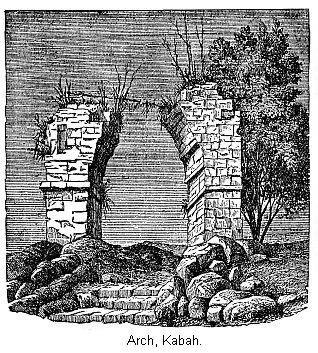
M. Charney has of late years made a discovery
which conclusively shows that this was an inhabited place at the
time of the conquest. In a room as ruined as the rest he
discovered the stucco-figure of a horse and its rider. They are
formed after the Indian manner by an inexperienced hand guided by
an over-excited imagination. Both figures are easily recognized.
The horse has on its trappings. We can see the stirrups. The man
wears his cuirass. We all know what astonishment the appearance
of men on horseback produced among the Indians, and so we are not
at a loss to divine the cause which led to the construction of
this figure. We must remember Mr. Stephens was hurried for time.
Portions of this figure were mutilated, and other portions had
been covered over by a layer of stucco, which Charney had to
remove before the figure could be distinctly made out.51
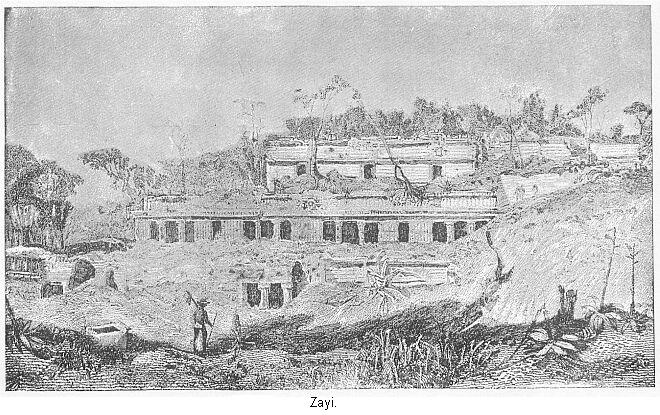
Within a radius of ten miles from Kabah are
located no less than six so-called cities. The general appearance
of all is the same—low ranges of buildings on terraced
mounds, and ornamented façades. One of these places, by
the name of Zayi, is of interest to us, because it gives us a
hint as to how these people constructed their buildings. Amongst
other buildings they found one large terraced mound, with
buildings arranged on it in a very significant manner. There were
three ranges of buildings, one over the other—the roof of
one range on a level with the foundation of the range above. A
grand stair-way led up the mound. This feature is illustrated in
the plate above. We can imagine what a grand appearance must have
been presented by this great terraced mound, when its buildings
were all perfect.
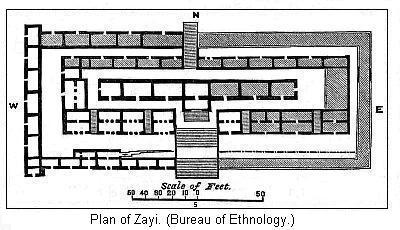
The plan of this mound and buildings is shown
in the last cut. Ten rooms on the north side of the second range
presented a curious feature. They were all filled up with a solid
mass of stone and mortar, and this filling up must have gone on
as fast as the walls rose, and the arched ceiling must have
closed over a solid mass. A very reasonable explanation is given
of this state of things by Mr. Morgan.52 He considers that such was the
rudeness of mechanical knowledge among these people that the only
way they could construct their peculiar arched roof was to build
it over an internal core of masonry. Once put together over such
a core, and carried up several feet, the down weight of the arch
would articulate and hold the mass together. Then the core of
masonry would be cleaned out, and the room was ready for use. If
this be true, it follows that these rooms were the last erected.
They were not yet cleared out when the operations of the
Spaniards put an end to all native building. We must notice the
structures at Zayi are in as ruined a condition as the
others—thus strengthening the conviction that their
abandonment was at about the time of the conquest of the
peninsula.
We have not space to follow Mr. Stephens in
all his journey. Every few miles he came across one of these
peculiar structures. A common design is apparent in all; but all
are alike enveloped in mystery. At Labna he found an extensive
field of ruins, equal in importance to any in Yucatan. The next
illustration represents an arched gateway, which reminds us of
that in the "House of Nuns." Passing through this he found
himself in a ruined court-yard, fronting which were the remains
of buildings; but this was only one of many groups of ruins, and
Labna was but one of many places visited. At Labphak Mr. Stephens
found "the tottering remains of the grandest structure that now
rears its ruined head in the forests of Yucatan." This was a
terraced mound, faced by buildings on three sides, leaving an
immense stair-way occupying the fourth side.

Small interior stair-ways are mentioned in
this building, but no particular description is given of them. At
two places sculptured tablets were found. These tablets are
worthy of notice. They were the only ones Mr. Stephens found,
except at Palenque. It will be seen, on the map, that this ruin
is nearer Palenque than any of the places in Yucatan yet
described. Stucco ornaments, so apparent at the latter place,
were now becoming numerous again. At Uxmal stone for building
could be had in the greatest abundance—it was not as plenty
here. The builders, apparently, adapted their ornamentation to
the material at hand; and, while at Palenque they employed stucco
in ornament, at Uxmal they carved stone.53
We must now leave this interesting section of
Yucatan, though only a few places have been mentioned. The reader
is well aware of the difference of opinion with which these ruins
are viewed. Some of them are unquestionably temples. If we regard
the others as palaces and the public buildings of great cities,
we are at once puzzled to account for their great numbers. If we
look on the majority of them as communal residences of the
inhabitants, we are amazed at the mass of decorations with which
they are adorned. But our admiration stops there—we are
accustomed to speak of them as stately edifices. This is owing to
their exterior ornaments, and their position on terraced mounds.
The houses are often of great length, but not striking in other
regards. The rooms, in the majority of cases, are small, low,
dark, and ill ventilated. A great amount of useless labor was
bestowed upon the walls, which were unnecessarily massive.
Near the center of the northern part of the
peninsula is seen a place marked Chichen, to which is generally
added the word Itza, making the entire name of the place
Chichen-Itza. In this case the ancient Maya name has come down to
us with the ruins—Chichen meaning the "mouth of wells,"
having reference to two springs which supplied the place with
water. Itza is the name of a branch of the Maya people. This
place is of interest to us in several ways. It was,
unquestionably, a renowned city in aboriginal times. Here the
Spaniards met with a very severe repulse. As a ruin it attracted
the attention of early writers, and it has been the subject of
antiquarian research in recent times. The description of the
buildings will not detain us long. They are, evidently, the work
of the same people as those whose structures we have already
described.
One of the most important buildings is known
as the Nunnery, reminding us at once of the collection of
buildings of that name at Uxmal. In this case, however, the
pyramid is represented by a solid mass of masonry one hundred and
twelve by one hundred and sixty feet, rising with perpendicular
sides to the height of thirty-two feet. This is seen to be a
departure from the method of constructing pyramids hitherto
described. The proprietor of the estate on whose grounds these
ruins are located used this mound as a stone-quarry. An
excavation of thirty feet revealed no secret chambers.
The probabilities are that it is solid
throughout. A grand staircase, fifty-six feet wide, leads up to
the top of this mound. Mr. Stephens tells us that three ranges of
buildings occupied the summit, and his drawings represent the
same. The roof of the one forms a promenade in front of the one
above. So each range of buildings rests on a foundation solid
from the ground. Mr. Bancroft describes this mound as having but
two ranges of buildings on the summit. Of these buildings the
second range was, seemingly, the most important. Several of its
rooms contained niches in the back wall, extending from floor to
ceiling. From traces still visible, they were once covered with
painted ornaments. One of the rooms was fifty-seven feet long and
nine wide.
In the rear wall of this room were nine of
these niches. "All of the walls of this room, from the floor to
the peak of the arch, had been covered with painted designs, now
wantonly defaced, but the remains of which present colors, in
some places, still bright and vivid; and among these remains
detached portions of human figures continually reappear, well
drawn, the heads adorned with plumes of feathers and the hands
bearing shields and spears." To this pile of masonry, at one end,
a wing had been attached. This building was similar in design to
other buildings in Yucatan. Theoretically we would expect this
wing to be much later in time than the buildings on the mound.
That it is so, is proven by the fact that in two rooms the
internal core of masonry, as described at Zayi, had not been
wholly removed.
We have noticed in all these structures, the
builders first threw up a mound or pyramid to support the
building. In one of the Chichen edifices the earth had been
excavated from all around it, so as to still present the
appearance of a mound. Perhaps the most prominent object at this
place is a stately pyramid, with an imposing building,
represented in the plate below. The mound itself is nearly two
hundred feet square, and rises to the height of seventy-five
feet. On the west and north sides are ruined staircases.
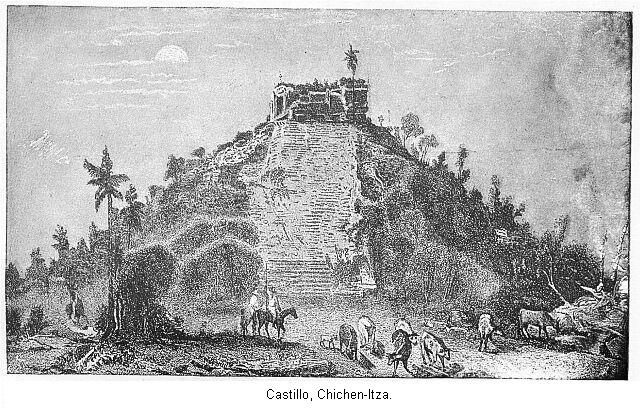
On the ground, at the foot of the stairway on
the north side, "forming a bold, striking, and well conceive
commencement to this lofty range, are two colossal serpents'
heads, ten feet in length, with mouths wide open, and tongues
protruding. No doubt they were emblematic of some religious
belief, and, in the mind of an imaginative people passing between
them, to ascend the steps, must have excited feelings of solemn
awe." The temple on the summit of this pyramid has some peculiar
features about it. It is nearly square—forty-three by
forty-nine feet—only one door in each side. In the room
within, instead of partition walls supporting arches, were two
immense beams, resting on square pillars, and supporting two
arches—the only instance in the ruins of Yucatan of such
use of beams.
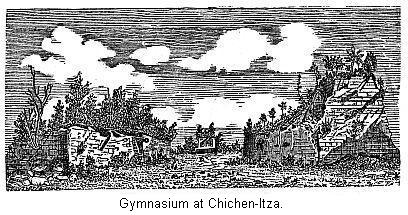
We now wish to speak of one class of ruins
which are present at Uxmal, but which we did not describe. They
are two parallel walls. On the plan of Uxmal they are noticed
between the Governor's House and the House of Nuns. This
illustration represents this feature. These walls are each two
hundred and seventy-four feet long, thirty feet thick, and
twenty-six feet high. The distance separating them is one hundred
and twenty feet. About one hundred feet from the north end, is
seen a building fronting the open space between the walls. A
building stood in a like position at the south end. In the cut a
stone ring is seen projecting from each side. On the rim and
border of these rings were sculptured two serpents, represented
below. The general supposition is that this structure was used in
the celebration of public games. Mr. Stephens refers us to the
writings of Herrera, an early historian, for a description of a
game of ball played at Mexico, where the surroundings must have
been much the same as is here represented.

Most of the structures in Yucatan have been
left in undisturbed quiet since the visit of Mr. Stephens. Five
years after his visit, the Indians rose in revolt, and a large
portion of country through which he traveled in perfect safety
has, since then, been shunned by cautious travelers. As he says,
"For a brief space the stillness that reigned around them was
broken, and they were again left to solitude and silence." At
Uxmal, and some places near the coast, more recent travelers have
investigated the ruins, wondered over them, and passed on,
without materially adding to our knowledge respecting them. In
1873 a French scientists Dr. A. Le Plongon, accompanied by his
wife, visited Yucatan for the purpose of exploring the ruins.
They spent a year in Meridia, thoroughly studying the customs of
the country, and preparing for work.
Their first field of work was this ancient
city, Chichen-Itza. As a result, he lays before us a picture of
life and times not only vastly remote from us, but surpassing in
wonder any thing hitherto presented. In the field of American
antiquities we need scarcely be surprised at whatever conclusions
are presented to us. We believe, however, we are not too harsh in
saying that scholars, as a rule, consider Le Plongon as too much
carried away by enthusiasm to judge coolly of his discoveries.54 The most important part of his
discoveries seem to have been in the buildings in connection with
the Gymnasium last described.
At the time of the Spanish conquest, a very
common tradition among the natives was that, in ancient times,
three brothers governed the country. This legend of three rulers
in olden times, was not peculiar to the Mayas, but was found
among all the Indian nations of Central America.55 In our opinion this last statement at
once shows we have here to deal with a question belonging to
mythology and not to history. But M. Le Plongon considers the
buildings at Chichen, especially those of the Gymnasium,
illustrative of the lives of the three brothers, and of the queen
of one of them. In brief, he tells us the names of these three
brothers were, Chaac-mol, Huuncay, and Aac. The first of these,
Chaac-mol, means Tiger King. It was he who raised Chichen-Itza to
the height of its glory. M. Le Plongon would have us believe that
the merchants of Asia and Africa traded in its marts, and that
the wise men of the world came hither to consult with the
H-men,56 whose convent, together
with their astronomical laboratory, is still to be seen. Aac was
the younger brother of the three. He conspired against the life
of Chaac-mol, and finally killed him. The queen of Chaac-mol then
erected the buildings around the Gymnasium as his memorial.

At the south end of the eastern wall Mr.
Stephens noticed two ruined buildings, an upper and a lower one,
of which our next cut is a representation. He was struck with the
remains of painting, which entirely covered the walls. He tells
us the walls were everywhere covered with designs in painting,
representing, in bright and vivid colors, human figures, battles,
houses, trees, and scenes of domestic life. We give, in a plate,
detached portions of these figures. We must understand that, in
the original, these were beautifully colored. The colors used
were "green, yellow, red, blue, and reddish brown, the last being
invariably the color given to human flesh."
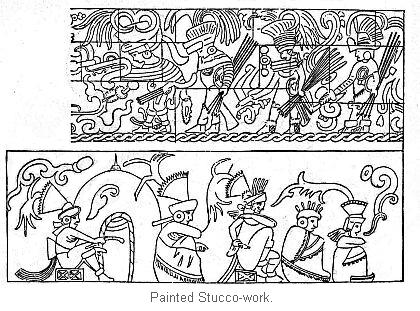
M. Le Plongon contends that these paintings
represent scenes in the lives of the three brothers and the Queen
of Chaac-mol, "in the funeral chamber." Says he: "The terrible
altercation between Aac and Chaac-mol, which had its termination
in the murder of the latter by his brother, is represented by
large figures three-fourths life size."57 And in another place he tells us: "The
scenes of his death is impressively portrayed on the walls, which
the queen caused to be raised to the memory of her husband, in
the two exquisite rooms, the ruins of which are yet to be seen
upon the south end of the east wall of the Gymnasium. The rooms
were a shrine where the conjugal love of the queen worshiped the
memory of her departed lover. She adorned the outer walls with
his effigies, his totem-tiger, and his shield and coat-of-arms
between tiger and tiger;58 whilst
on the admirably polished stucco, that covers the stones in the
interior of the rooms, she had his deeds—his and her own
life, in fact—painted in beautiful, life-like designs,
superbly drawn, and sweetly colored."59
He tells us further, that Aac, after the
commission of his crime, fled to Uxmal for protection, where he
built the edifice described as the "Governor's House." The seated
figures over the central door-way, he says, represents Aac.
In the hieroglyphics around the head he finds the name. Although
neither Mr. Stephens nor the other travelers mention any thing of
the kind, he says that, under the feet of this figure, "are to be
seen the bodies of three figures, two men and one woman,
flayed."60 Though the figures are
headless, he has no doubt but that they represent Huuncay,
Chaae-Mol, and the queen, his wife. We are further told that the
ruined structure on the second terrace, called the "House of
Turtles," was Aac's private residence.

This wonderful story of the lives and
adventures of the three brothers was revealed to the doctor by a
careful study of the detached painting mentioned by Mr. Stephens.
One of the paintings which served him so good a turn is shown in
the cut above, which he considers represents the queen, when a
child, consulting one of the wise men as to her future destiny.61
Perhaps as interesting a portion of his
discoveries as any, is finding sculptured figures of bearded
white men on the pillars of the temple, and painted on the walls
of Chaac-mol's chambers. He thinks they have Assyrian features.
He also claims to have discovered figures having true Negro
features.
As to the antiquity of this city he readily
figures up nineteen thousand years; but this did not take him to
the beginning. He arrives at this estimate in this way: To the
north-east of the pyramid, we have described, are to be seen rows
of small columns, which have excited the curiosity of all who
have seen them. Mr. Stephens represents them in four rows,
inclosing a rectangular area. M. Le Plongon says they surrounded
three sides of a terraced pyramid, which once supported the main
temple of the city. Mr. Stephens has no suggestions to offer as
to their use.
Le Plongon claims they were used to measure
time, and quotes from old authors to the effect, that each stone
in them stands for twenty years; and, as there is always just
eight stones in a column, each column means one hundred and sixty
years. He counted one hundred and twenty of these
columns—and then, as he says: "Got tired of pushing my way
through the nearly impenetrable thicket, where I could see many
more among the shrubs." From this number he computes nineteen
thousand two hundred years.
What shall we say to this story that M. Le
Plongon brings us of ancient Maya civilization? It is
unquestioned that he has expended a great amount of patient labor
in his work, has braved many dangers, and is thoroughly in
earnest. He has also spent years in the field, and ought to be
well qualified to judge of the ruins. We believe, however, he is
altogether wrong in his conclusions. The keystone of his
discoveries—the one on which he relies to prove the
accuracy of his methods—fails him. This was the discovery
of the statue of Chaac-mol himself, which is here represented. He
claims to have found it as the result of successfully rendering
certain mural tablets in the funeral chamber, but a careful
reading of his own account of the affair leaves us under the
impression that the "instincts of the archæologist" had as
much to do with it as any thing else.62
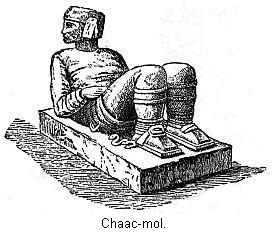
Be that as it may, he certainly did find this
statue buried in the ground. He is very positive it is Chaac-mol,
claiming to have read the name readily in hieroglyphics on the
ear-tablets. He says: "It is not an idol, but a true portrait of
a man who has lived an earthly life. I have seen him represented
in battle, in council, and in court receptions. I am well
acquainted with his life, and the manner of his death." This
statue was seized by the Mexican Government, and taken to Mexico.
Here a curious discovery was made. Another statue similar to this
was already in the museum. This latter had been found not far
from Mexico. Since then, still a third, smaller than the others,
but evidently representing the same personage, has been
discovered. In short, it has been shown that this is an idol,
worshiped as well by the Aztecs as by the Mayas, and, instead of
being buried, as Le Plongon asserts, five thousand years ago, we
have not much doubt it was buried to prevent its falling in to
the hands of the Spaniards.63
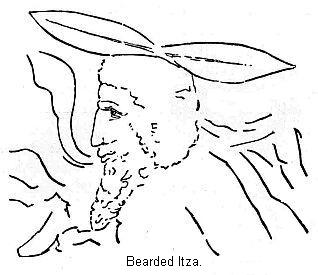
As to the antiquity with which Le Plongon
would clothe Chichen, if his method be right, he has not more
than made a beginning. Mr. Stephens counted three hundred and
eighty of these same columns, and tells us there were many
more.64 We know no good reason
for supposing Chichen was not inhabited at the time of the
conquest. The wooden beams and lintels in the temples have not
yet decayed, and the masonry had not been cleaned out of some of
the rooms. On this point we wish to make a suggestion, a mere
hint. The pillars that supported the arches in the temple
mentioned some pages back were covered with sculpture. Amongst
some others, but very faintly represented, was the preceding
figure of a bearded man. May it not be that it represents a
Spaniard? We must recall the stucco figure of the horse and its
rider at Kabah. It seems to us a reasonable suggestion that they
should carve on the pillars of their temples representations of
the Spaniards, for the Spaniards were twenty-five years in
gaining a permanent foothold in Yucatan, and during that time the
Indians would continue to build and ornament as before.
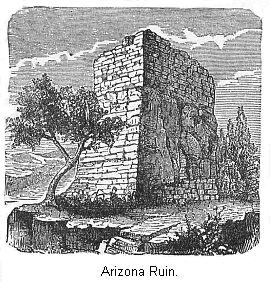 REFERENCES
REFERENCES
- Bancroft: "Native Races," Vol. V, p. 78.
- Stephens's "Incidents of Travel in Central America, Chiapas,
and Yucatan," Vol. I, p. 113, et seq.
- Bancroft's "Native Races," Vol. IV, p. 95.
- "Report of Bureau of Ethnology," Vol. I. Mr. Holden's
article.
- Fourteen years later, these ruins were visited and described
by an Austrian traveler, Dr. Scherzer. His account, though much
more complete than Mr. Stephens's, has not yet appeared in
English. Mr. Bancroft, in "Native Races," Vol. IV, p. 118, et
seq., gives a résumé of all information
known as to these ruins.
- "Central America," Vol II, p. 122. We are not sure about this
inclosure. But Mr. Catherwood mentions a wall, and we are told
the ruins are, in all respects, similar to those of Copan.
- For full information consult Bancroft's "Native Races," Vol.
IV, pp. 115 to 139.
- "Central America," Vol. II, pp. 152-3.
- Brasseur De Bourbourg styles Fuentes's description of Copan
"La description menteuse de Fuentes." Bancroft: "Native Races,"
Vol. IV, p. 80, note.
- Charney, in North American Review, 1881.
- "Native Races," Vol. IV, p. 300, et seq.
- Morgan's "Contribution to N.A. Ethnology," Vol. IV, p.
268.
- Bancroft's "Native Races," Vol. IV, p. 319.
- Armin: "Das Heute Mexico."
- "Native Races," Vol. IV.
- Bancroft's "Native Races," p. 326.
- Short's "North Americans of Antiquity," p. 389.
- Holden, in "First Annual Report of the Bureau of
Ethnology."
- Brasseur De Bourbourg.
- "Myths of the New World."
- Holden, in "First Annual Report Bureau of Ethnology."
- This tablet is named after its discoverer. The building in
which it is situated was but a short distance from the others;
yet, owing to the density of the forest, neither Waldeck nor
Stephens discovered it. A cast of it is now in the National
Museum at Washington.
- Rau, in "Smithsonian Contribution to Knowledge," Vol. XXII,
p. 40.
- "Myths of the New World," p. 95.
- Bancroft's "Native Races," Vol. V, p. 506.
- See, also, "American Encyclopedia," Art. "Cross."
- "Conquest of Mexico," p. 160.
- "Smithsonian Contribution to Knowledge," Vol. XXII.
- Bancroft's "Native Races," Vol. III, p. 470.
- "Annual Report of the Bureau of Ethnology," Vol. I.
- Mr. Holden uses, as an important link in his arguments, a
figure engraved on a chalchiute (a sacred stone). He concludes it
to be a representative of Huitzilopochtli, the god of war, or
rather the Maya representative of the Mexican god of that name.
It is unfortunate that Prof. Valentine gives to this same figure
a different significance. In the "Proceedings of the American
Antiquarian Society," for April, 1884, in a paper on that
subject, he concludes it to be a representation of a victorious
warrior giving sacrifice to his god. The only persons entitled to
speak on such subjects are those thoroughly acquainted with Maya
Archæology.
- Huitzilopochtli.
- Tlaloc.
- Bancroft's "Native Races," Vol. III, p. 324.
- While such seem to us to be the results of Mr. Holden's
labors, it must not be understood that he vouches for them. They
must be regarded as personal views which we express with some
mental forebodings. In this matter we must abide by further
investigations.
- Bandelier: "An Archæological Tour in Mexico," p.
184.
- Bancroft's "Native Races," Vol. IV, p. 345.
- See Charney, in North American Review, 1881. They wore
formerly in a house.
- Bancroft's "Native Races," Vol. IV, p. 332.
- Brinton's "Contribution to North American Ethnology," Vol. V,
p. 36. "Introduction to Study of Manuscript Troano," by Prof.
Thomas.
- North American Review, February, 1881, p. 187.
- Bancroft's "Native Races," p. 287.
- "Central America," Vol. II, p. 261. At this time Mr. Stephens
had not seen the ruins at Palenque, and those in Yucatan.
- Pronounced "oosh-mal."
- Our principal authority on the ruin's of Yucatan is Mr.
Stephens, whose work, "Incidents of Travel in Yucatan," in two
volumes, is all that can be desired. Mr. Bancroft, in "Native
Races," Vol. IV, has gathered together whatever of worth there is
in the writings of various explorers.
- Mr. Stephens thinks they were for the support of the arches,
while building. As, however, it is almost certain they
constructed this arch over a solid cove of masonry, which they
afterwards removed (see "Contributions to N.A. Ethnology," Vol.
IV, p. 262), they could not have been intended for such use.
- The pyramid is three hundred and fifty feet square at the
base and nineteen feet high. The terraces are along the south
side. The lowest terrace is three feet high and twenty feet wide.
The second is twelve feet high and forty-five feet wide. The
third is four feet high and five feet wide. The building on the
south side is two hundred and seventy-nine feet long,
twenty-eight feet wide, and eighteen feet high. The north one is
two hundred and sixty-four feet long, twenty-eight feet wide, and
twenty-five feet high. The eastern one, one hundred and
fifty-eight feet long, thirty-five feet wide, and twenty-two feet
high. The western one, one hundred and seventy-three feet long,
thirty-five feet wide, and twenty feet high. (Bancroft's "Native
Races," Vol. IV, p. 174.) The area of the court is two hundred
and fourteen feet by two hundred and fifty-eight feet. It is
about two and a half feet lower than the buildings on the
eastern, western, and southern sides. There are seventy-six rooms
in the four ranges of buildings, and twelve more in the facings
of the terrace of the north building, to be described. In size
the rooms vary from twenty to thirty feet long by from ten to
twelve feet wide.
- Bancroft: "Native Races," Vol. IV, p. 179.
- The dimensions of this mound are as follows: Length of base,
two hundred and thirty-five feet; width of base, one hundred and
five feet; height, eighty-eight feet. Though diminishing as it
rises, it is not exactly pyramidal, but its corners are rounded.
It is incased with stone, and is apparently solid from the
plain.—Stephens's "Yucatan," Vol. I, p. 316.
- See "Proceedings Am. Antiq. Society," April, 1880, p.
57.
- North American Review, 1882.
- "Contributions to North American Ethnology," Vol. IV, p.
267.
- Stephens's "Yucatan," Vol. II, p. 164.
- Short's "North Americans of Antiquity," p. 396; Charney:
North American Review, October, 1880.
- "Proceedings Am. Antiq. Society," Oct., 1878, p. 73.
- Learned men of the Mayas.
- American Antiquarian Society, October 1878.
- The tigers can be seen on the engraving of the
gymnasium.
- Proceedings American Antiquarian Society, April, 1877, p.
97.
- Proceedings American Antiquarian Society, April, 1877, p.
101.
- M. Le Plongon interprets the curved figures issuing from the
throat of the wise-man. In the original, different parts of this
figure were of different colors. The doctor frankly tells us,
that "imagination does the greater part of the work" in his
interpretation.
- "Guided, as I have said, by my interpretations of the mural
paintings, bas-reliefs, and other signs, . . . I directed my
steps, perhaps inspired by the instincts of the
archæologist, to a dense part of the thicket." Proceedings
Am. Antiq. Society, April, 1877, p. 85.
- North American Review, October, 1880. And yet there
are indications that this is a statue. See Bandelier's
"Archæological Tour in Mexico," p. 74.
- Stephens's "Yucatan," Vol. II, p. 318.
Chapter XIII: The Nahua Tribes.
Chapter XV: The Culture of the
Civilized Tribes.
 THE Central American region of
the Western Continent are found the ruins of what are pronounced
by all scholars to be the highest civilization, and the most
ancient in time, of any in the New World. There it arose,
flourished, and tottered to its fall. Its glory had departed, its
cities were a desolation, before the coming of the Spaniards. The
explorer who would visit them finds himself confronted with very
great difficulties. Their location is in a section of the country
away from the beaten track of travel. Their sites are overspread
with the luxuriant vegetation of tropical lands, through which
the Indian's machete must carve a passage. The states in which
they are situated are notorious for anarchy and misrule, and the
climate is such that it is dangerous for those not acclimated to
venture thither during a large part of the year. So it is not
strange that but few have wandered among these ruins, and
described them to the world at large.
THE Central American region of
the Western Continent are found the ruins of what are pronounced
by all scholars to be the highest civilization, and the most
ancient in time, of any in the New World. There it arose,
flourished, and tottered to its fall. Its glory had departed, its
cities were a desolation, before the coming of the Spaniards. The
explorer who would visit them finds himself confronted with very
great difficulties. Their location is in a section of the country
away from the beaten track of travel. Their sites are overspread
with the luxuriant vegetation of tropical lands, through which
the Indian's machete must carve a passage. The states in which
they are situated are notorious for anarchy and misrule, and the
climate is such that it is dangerous for those not acclimated to
venture thither during a large part of the year. So it is not
strange that but few have wandered among these ruins, and
described them to the world at large.




















































